While luxury brands have long had relationships with the fields of theater, dance, film, music and literature, now they are taking on more active roles in the entertainment industry, raising their profile from partner to producer.
Due to the lifestyle associated with the luxury business, these brands make frequent appearances in entertainment, with placements ranging from organic mentions to product placement. Associating themselves with forms of entertainment or becoming the entertainment allows luxury brands to market themselves to a broader audience without sacrificing their image or exclusivity.
"The biggest tool entertainment marketing provides for luxury brands is not only the potential for immediate sales, but that it opens the doors to a massive opportunity to engage millennials who may not quite have the ability to afford luxury now, but will aspire to purchase that brand one day in the near future, as they rise in their careers," said Stacy Jones, CEO of Hollywood Branded, El Segundo, CA.
"This includes celebrity endorsement deals inclusive of social posts, product placement in films, TV shows and music videos, as well as event sponsorship activations at trendy fashion driven events like Coachella," she said. "Brands participating in these hip and cool opportunities with celebrities make the brand less stuffy, less like their mom’s—or worse yet—grandmother’s brands, and more appealing.
"Using entertainment marketing to communicate with these younger buyers is key to luxury brands’ success."
Top 5 trends in entertainment marketing:
Brands as entertainment producers:
A number of luxury brands have taken on production projects, creating everything from music videos and films to original songs through in-house studios.
Sponsorship deals:
Luxury labels have linked up with live events as far ranging as the ballet and music festivals, looking to reach attendees through a shared passion for art.
Elevated product placement:
While product placement has been around for a long time, some brands have taken the marketing concept to another level, turning an appearance in a film or television show into a multifaceted campaign. A number of brands have also created special collections tied into a particular movie.
Celebrities as muses and models:
Famous faces from the entertainment industry are common choices for brand ambassadors, as luxury labels look to align themselves with the glitz and glamour of celebrity. These spokesmodels also provide brands with household name recognition by association.
Celebrities-turned-luxury competition:
While celebrities frequently serve as the faces of luxury campaigns, a number of entertainment industry personalities have evolved their personal brand into a lifestyle company. Certain players, including Kanye West and Rihanna, have launched fashion and beauty lines that retail alongside luxury brands in stores such as Barneys New York and Harvey Nichols.
The big screen
Luxury brands have often been attractive partners for films, particularly when a production wants to convey a sense of affluence or aspiration.
In the blockbuster movie “Fifty Shades of Grey,” Audi, Omega and a number of home furnishings labels were among the brands used to convey the billionaire lifestyle of the titular character, Christian Grey (see story).
While the product placement likely made an impact, Audi expanded on its appearance with a parody spot (see story).
Similarly transforming a film partnership into a larger branding opportunity, Mr Porter’s association with the British spy franchise "Kingsman" has seen merchandising and marketing efforts that take the association beyond the screen. Between the launches of the two films, Mr Porter created a GIF generator to place consumers within scenes from the film and opened a dedicated pop-up shop (see story).
Automakers frequently partner with action and superhero films, with the relationship often going beyond simple product placement.
Mercedes-Benz is heralding its appearance in the upcoming release “Justice League” with television and digital ads. The automaker is also debuting a branded comic (see story).
Aside from serving as props or costumes for fictional plots, luxury brands have found their way into movie theaters courtesy of documentaries. From Tiffany & Co. to Bergdorf Goodman, the stories of some of luxury’s key players have proven popular topics for behind-the-scenes features, owing to the audience’s interest in the glamorous world of luxury.
Film is one area where luxury brands have struck out on their own, commissioning filmmakers or producing their own features.
Prada’s Miu Miu, for instance, established a series of female-directed films dubbed Women’s Tales. To-date, the project has released 14 shorts from talents including Chloë Sevigny and Miranda July (see story).
BMW has similarly developed a series of short movies, tapping producers and directors who work in Hollywood. The latest BMW Films project, “The Escape,” featured Clive Owen and Dakota Fanning (see story).
In 2013, Swarovski Entertainment premiered its maiden feature film, marking the first time the crystal maker had worked with Hollywood partners to develop, finance and produce a film. The adaptation of Shakespeare’s “Romeo & Juliet” debuted alongside a corresponding jewelry collection (see story).
Official Romeo & Juliet (2013) trailer presented by Swarovski Entertainment
In addition to working with established filmmakers, luxury brands have also given a voice to budding talent through projects.
Armani’s ongoing Films of City Frames initiative invites film school students to tell stories surrounding its eyewear (see story). More recently, the brand launched its Armani/Laboratorio coursework in Milan to train up-and-coming filmmakers in aspects such as makeup artistry and editing (see story).
At the Condé Nast International Luxury Conference in 2016, Armani global communications director Claudio Calò spoke of how the brand has leveraged the power of cinema to elevate its brand beyond products. Fashion and cinema have had a dialogic relationship for decades, and by leveraging cinematic tools, fashion brands can give themselves and their products a fuller lifestyle (see story).
This symbiotic relationship between luxury and film is on view at events around the globe, such as award shows and film festivals, as luxury brands sponsor VIP lounges or launch other activations aimed at engaging the filmmaking community.
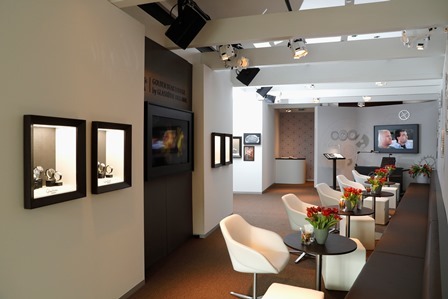
The Golden Bear Lounge by Glashütte Original at the Berlin International Film Festival in 2017. Image credit: Glashütte
For instance, Jaeger-LeCoultre’s “The Art of Behind the Scenes” exhibit has been on view in Cannes, New York and Los Angeles to align with industry events. The display, curated by Finch & Partners, features photographs that captured the making of some iconic films (see story).
Tuning in
As with film, television is also home to luxury product placement. In addition to coordinated placement, luxury labels make appearances both in scripted shows and reality television.
Along with cameos, sometimes brands become the main event.
For instance, an episode of the modeling competition show “The Face” featured a challenge revolving around Maserati’s Quattroporte, wherein contestants were asked to create a commercial for the car. Unlike the fleeting nature of product placements that can stay invisible to consumers, structuring an entire episode around a product likely creates a greater impact (see story).
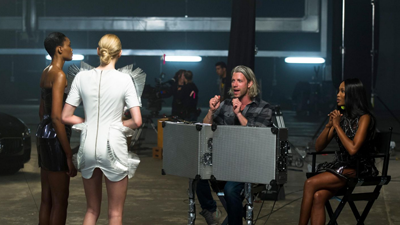
Maserati on "The Face."
Television shows that feature affluent characters frequently call upon luxury labels to add a touch of aspiration to scenes. For instance, an episode of The CW’s “Gossip Girl” depicted a private sales appointment with a Cartier brand representative (see story).
Taking this approach a step further, a number of companies have developed branded content.
“House of DVF,” which ran for two seasons on the E! network, featured a group of 10 millennial women vying for the chance to be a brand ambassador (see story).
Lexus’ branded series “Verses and Flow” is a variety show designed to reach an African American audience through performances ranging from spoken word to music (see story). Additionally, the automaker’s content channel L/Studio positions itself as a substitute for a streaming service, serving up shows ranging from the comedic to the inspirational.
I Turn My Camera On Trailer | L/Studio Created by Lexus
Branded partnerships with television shows and channels are also popular.
Tag Heuer inked a sponsorship deal with RedBull TV, putting its brand within the digital media platform (see story), while Ralph Lauren became a corporate sponsor of the U.S.’ Public Broadcasting Service’s Masterpiece (see story). Cartier similarly sponsored CNN’s “Ones to Watch” series, which featured up-and-coming artists (see story).
Tie-ins with television shows offer a chance to bring a viewing audience to a brand’s channels.
Lexus teamed with ABC’s “Quantico” on a second-screen virtual reality experience. The interactive scripted content allowed consumers to take on the role of a new FBI recruit (see story).
Musically minded
Live events offer a means for brands to deliver an immersive experience. Therefore, performances such as music festivals and concerts have been a frequent choice of luxury brands looking to engage with particular audiences.
"One reason luxury brands are working with live entertainment is that each entertainment platform creates an experience for the event goer," said Keetria Garner-Chambers, entertainment marketing director at AMW Group, Houston.
"Luxury brands want to tap into that excitement and enjoyment within those environments where individuals would be more receptive and inclined to their ad campaigns," she said. "What better way to do that than reaching people who are happy and excited, and luxury brands can cater their promotional messages to target a specific demographic."
In an effort to appeal to the next generation of luxury consumers, Tag Heuer became a sponsor of the Coachella Valley Music & Arts Festival in 2016. The watchmaker had a branded tent in the VIP section, which included a photo booth and an interactive display about its Connected watch (see story).
Also catering to a younger crowd, Gucci hosted the EDM festival Club to Club at its Milan headquarters (see story).
Embracing a different genre, BMW has worked with symphonies in London, Munich and Berlin to bring live classical music to audiences for free. The London concerts have drawn out a considerable crowd of first-time symphony attendees and those under the age of 35 (see story).
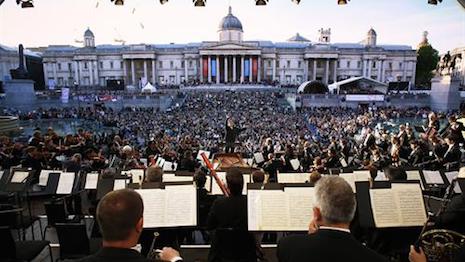
BMW LSO Open Air Classics in 2017. Image courtesy of BMW
Whether with their blessing or not, luxury brands are frequently name-dropped in popular music.
A number of brands such as Michael Kors, Tom Ford, Versace, Richard Mille, Maybach, Mercedes-Benz and others have been mentioned in hip-hop, rap, pop and rock songs that have topped the charts. By being mentioned in these lyrics, musicians are giving an organic endorsement of a brand that may encourage consumers to buy certain brands instead of others (see story).
Often, brands choose to let these references go by without acknowledgement.
However, recently Versace fully embraced its title placement in Bruno Mars’ “Versace on the Floor.” From creating custom attire for the artist and his music video costar Zendaya to filming its own lip synch to the track, Versace showed it was on-board with its association (see story).
Bruno Mars - Versace On The Floor Official Video
Chaumet also took Chinese singer Zhang Yixing’s music video for “I Need U” as a branding opportunity, letting the artist film within its Paris boutique and salons (see story).
Creative directors, including Gucci's Alessandro Michele and Givenchy's former designer Riccardo Tisci, have lent their creative talents to music videos (see story).
Brands’ music appreciation has also manifested in curated digital playlists and channels, such as Apple Music’s partnerships with Burberry and Chloë (see story).
"Luxury brands have always associated themselves with celebrities by using these individuals in celebrity endorsement campaigns," Hollywood Branded's Ms. Jones said. "But in those instances, the brand has to fund and control how the consumer is going to see that partnership. The brand is going to have to create the ad, purchase the media or produce the red carpet event.
"What entertainment marketing content opportunities in TV, film, music videos or related events do is provide the platform as well as the celebrity – the brand simply needs to show up to take advantage of potential global awareness," she said.
On stage
Similar to music, theatrical performances and dance have the ability to engage live audiences. Luxury brands have sought placement as sponsors of performances, putting themselves in front of affluent attendees.
For instance, as part of its artistic patronage, Ruinart became the official Champagne of the New York City Ballet in 2014. As part of its new role, Ruinart opened a branded Champagne bar at the company’s home at the David H. Koch Theater in Lincoln Center (see story).
Mr Porter similarly sponsored the London run of a musical adaptation of Bret Easton Ellis’ “American Psycho.” The retailer promoted its role and the show itself through a themed edition of its online magazine The Journal (see story).
Van Cleef & Arpels’ gems have served as the inspiration for choreographers George Balanchine and Benjamin Millepied, who translated the concept of the precious stones into dance.
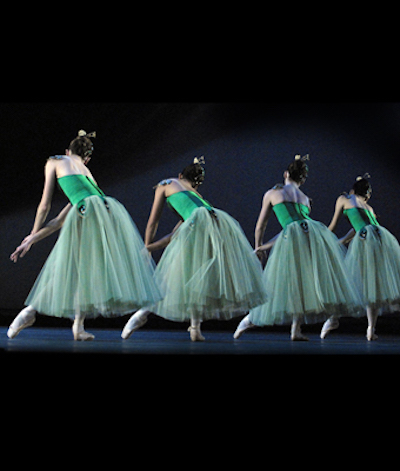
Emerald section of George Balanchine's "Jewels" ballet. Image credit: Van Cleef & Arpels
Taking on the role of producer, Fornasetti staged a version of Wolfgang Amadeus Mozart’s opera “Don Giovanni.” Fornasetti’s production included set designs that took inspiration from some of the brand’s motifs (see story).
Taking advantage of their fashion expertise, luxury brands have frequently been called upon to serve as the costume designers for productions.
Valentino linked with the Teatro dell’Opera di Roma for its staging of opera “La Traviata,” while Balmain was tapped to design costumes for ballet dancers at the Paris Opera (see story).
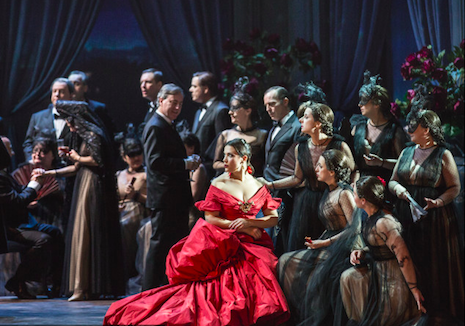
The costumes for "La Traviata" were designed by Valentino. Image credit: Teatro dell'Opera di Roma, photo by Yasuko Kageyama
Dance and fashion have a symbiotic relationship, with designers appearing on-stage and performers starring in marketing efforts.
For instance, Alexander McQueen teamed up with French ballet dancer Marie-Agnès Gillot for an Another magazine shoot (see story).
London’s The Dorchester has also collaborated with the English National Ballet School to add a touch of performance to its afternoon tea.
"Entertainment marketing is by definition entertaining," said Damian Bazadona, president/founder of Situation, New York. "It’s a simple concept, but it’s not easy to be entertaining, and today, it’s what separate good brands from great brands.
"Entertainment marketing often takes the form of an event or an experience, and great brands create great experiences for their consumers," he said.
"Digital media amplifies the magic of the experience. It’s how the impact of an event or campaign can be extended beyond just the four walls of the venue or the limited number of people the space could accommodate.
"And by capturing content that tells the story of the event or campaign, you create another touchpoint that allows you to reach a wider audience and communicate just what the experience of your brand is."
Playing games
Leveraging gaming’s ability to engage, luxury brands have sought placement in the medium.
Drawing off Balmain creative director Olivier Rousteing’s friendship with reality television celebrity Kim Kardashian, the French label made appearances in her mobile game. Players could dress avatars in Balmain runway looks and also see Mr. Rousteing in animated form as they played (see story).
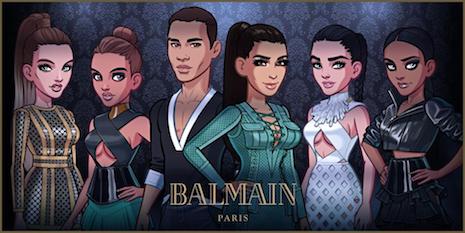
Balmain for Kim Kardashian Hollywood. Image credit: Kim Kardashian Hollywood
Similarly, automakers have often teamed with racing franchises to show off their vehicles. Lamborghini offered players of Microsoft Turn 10 Studios’ racing franchise Forza the ability to drive its Centario in the game before the model was available for the real road (see story).
Gamification has also become a tactic employed by brands in the in-store environment or digital channels. For instance, LVMH’s DFS allowed consumers to test their skills in a “Pink Jungle” to promote a Michael Kors collaboration (see story).
With the growth of entertainment on mobile and digital, brands are discovering that by creating marketing efforts with a game-like experience, they make a larger impact.
Italian fashion house Fendi and London’s Harrods department store recently worked together to create a memory game on mobile where users had to match photos of the brand's handbags. According to a Fashionbi report, marketers are adopting more strategies such as this in an attempt to better connect with consumers, with market spend in this way likely to overtake traditional spend (see story).
Read all about it
Along with becoming creators of performance art and cinema, luxury brands have also tried their hand at publishing.
Louis Vuitton has drawn from its positioning as a travel-centric house for a series of travel books. The set of 15 City Guides covers international destinations such as Paris, Beijing, New York and Moscow (see story).
Aside from films, coffee table books are another way to tell a brand story in long-form. These volumes reassert brand positioning and heritage while also allowing consumers to keep a piece of a favorite label in their own home.
As luxury has done with other artistic mediums, brands also act as curators and sponsors of the written word.
The annual Prada Journal competition, in partnership with publisher Giangiacomo Feltrinelli Editore and the label’s eyewear licensee Luxottica, has asked authors to submit works related to a themed prompt. After judging, the winning writer receives a cash prize and publication of their e-book.
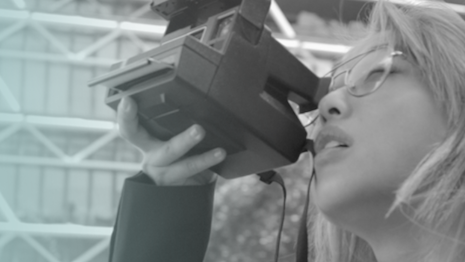
Prada Journal is moving away from print and text and towards visuals and images. Image credit: Prada
This year’s contest centers on the storytelling power of images, asking interested participants to share photos, illustrations or video for a chance to be featured on a multimedia gallery (see story).
Famous faces
Luxury brands often seek out relationships with the entertainment industry’s most notable names, whether dressing them for a red carpet affair or bringing them on-board as an ambassador.
Many of these associations have been long-term, as actors or musicians appear in multiple ad campaigns for a particular house or make appearances at parties or events.
"What we’re seeing is that there really is a commitment from the brands to work with talent that really is living those brands before they go sign and partner with them," said Matthew Lalin, founder of Starpower, New York. "And it’s more challenging for us as an agency, but it’s almost better, because when you find those right fits, it’s special.
"It’s about aligning from a pop culture perspective with what are the core values of the brand and what can that talent or property offer you that aligns with your core values," he said.
Mr. Lalin looks at the celebrity-brand partnership as a give and take, as brands should also find ways to tap into a star's passions, while also looking at them as a media platform.
Along with popularity or prestige from awards won or high-profile work, today brands also look at a celebrity’s social media prowess and audience as a deciding point.
Although the definition of what constitutes a celebrity has evolved with the advancement of social media, a report by Celebrity Intelligence finds that 40 percent of agency respondents feel that celebrity-driven marketing strategies remain very effective. Close to eight in 10 brands have worked with a celebrity on a social media strategy (see story).
Some brands have taken the celebrity relationship a step further, tapping a personality as a collaborator in the design process.
Pop star Rihanna, for instance, has teamed with Dior, Chopard and Manolo Blahnik on collections that reflect her personal style.
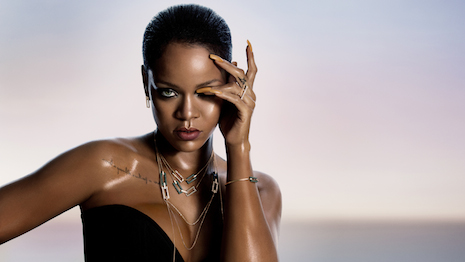
Rihanna modeling the Rihanna Loves Chopard jewelry collection. Image credit: Chopard
The singer, who has also branched into acting, was found to be the most marketable celebrity in rankings by the NPD Group. When an endorsement partnership is strong, fans of the celebrity are at least 50 percent more likely to make a purchase from the brand (see story).
Due to the enhanced interest to buy, entertainment personalities can lend support to brand charity efforts. For instance, Rolls-Royce invited music legends to take advantage of its bespoke capabilities for a good cause.
The brand commissioned collaborators such as The Who’s Roger Daltrey and The Kink’s Sir Ray Davies to put their own spin on Wraiths, with the resulting vehicles being sold to fundraise for charities. The first four cars in a series of nine Wraith “Inspired by British Music” vehicles were unveiled on March 29 at the Sanderson Hotel in London (see story).
While celebrity relationships can often bring more notoriety to a brand thanks to the star’s fame, brands need to do their due diligence when picking partners.
When working with a celebrity there are inherent risks, as the ambassador is invited into the brand’s inner workings and serves as a real-life representation of the company’s positioning. Despite being the face of a brand, celebrity ambassadors also have personal lives, careers and opinions that may occasionally outshine or undermine the message the brand is hoping to portray via its selected spokesmodels (see story).
To lower this risk, Mr. Lalin stressed the importance of brands doing their due diligence on a potential ambassador. His firm advises clients to run a background check on celebrities, with the star's knowledge, before signing.
"It’s one thing to just do a contract, but it’s another thing to truly develop a relationship with that potential partner," Mr. Lalin said. "And I think that’s also key, too, so you really learn who you’re aligning your brand or your product with.
"There’s always going to be risk, but the more due diligence you do, the least risk there becomes."
Aside from acting as luxury partners, celebrities have also become luxury competition as performers turn into lifestyle moguls. From Madonna’s MDNA skincare line to Kanye West’s Yeezy adidas collection, celebrity brands are carried alongside more traditional luxury labels in high-end retailers such as Barneys New York.
Inspiration point
Entertainment frequently plays a key role in the development of products, services and marketing initiatives.
Brands have taken inspiration from pop culture and entertainment for collections and campaigns.
For instance, Turnbull & Asser looked to both James Bond and cult classic cartoon character Mr. Benn for a line of pocket squares, depicting the animated figure as the famed spy (see story).
Marc Jacobs likewise paid homage to 1980s MTV with a capsule collection that launched before the television networks’ Video Music Awards last year (see story).
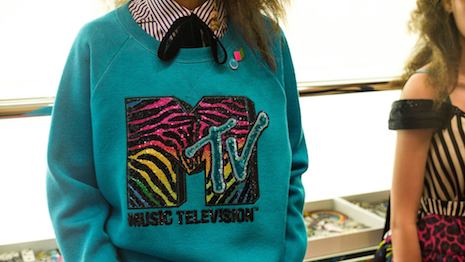
Marc Jacobs resort 2017 collection. Image credit: Marc Jacobs
Luxury marketing has also co-opted some of its tactics from the entertainment industry.
Brand films sometimes blur the boundaries between commercial messaging and pure storytelling. They have also challenged marketing norms with long-form content.
Chanel has made a number of films dedicated to the story of its founder Gabrielle “Coco” Chanel. For instance, the brand's "Once Upon a Time," directed and produced by creative director Karl Lagerfeld, clocked in at 18 minutes.
Starring actress Keira Knightley, the longtime ambassador for Chanel’s Coco Mademoiselle fragrance, the film starts in 1913 when Gabrielle “Coco” Chanel has opened a namesake hat boutique in on the Rue Gontaut-Biron in Deauville, France (see story).
"Once Upon A Time..." by Karl Lagerfeld
Brands have also turned music producer to get their point across.
French perfume house Fragrance Du Bois promoted the sustainable use of one of its main ingredients by producing a song in collaboration with Arab singer Nadeem Nour.
The song, titled “Life’s Treasure,” was written to celebrate the dark, resinous heartwood commonly known as Oud or Agarwood that is a key ingredient in many perfumes and incense (see story).
"The consumer is very smart, and I think the consumer is conscious of, ‘I like brand x, I’m celebrity y, you should buy me’ versus a brand really understanding who their consumer is and creating content that that consumer is going to want to watch, consume and believe in," Starpower's Mr. Lalin said. "A lot of people say, ‘Do you concern yourself, because then maybe that’s competing with what you do?’ But I think it’s actually really good for the industry, because it shows that brands are making a commitment to the space.
"Given the landscape that we’re in, pop culture does play a role in everything that’s going on in the world, and if content can be created in a smart, articulate way to tell a really creative story and one that comes with a positive message, whether brands are doing that internally or working with agencies, I think that’s great."
Best practices for entertainment marketing:
- Situation's Damian Bazadoza:
- "Behave like an experience. Great experiences use each consumer touchpoint as an opportunity to connect with them directly and enhance their experience. And every single touch point matters. Most people flop on this point. They focus on the obvious, shiny objects; but forget the small, seemingly insignificant moments where you can have significant impact.
- "Don’t overpromise and under-deliver. Creating a remarkable experience is far harder than most people realize. Make the proper investments so you can be successful."
- AMW Group's Keetria Garner-Chambers:
- "Do your research before considering teaming with an entertainment marketing partner. Make sure you’re familiar with the event or influencers audience and their interests.
- "Consider the potential reach of your promotional message. Even if you don’t have product available to give away or for direct purchase, any marketing collateral and other ways to connect with the audience will be a way for them to mention your brand name when recounting their experience to others."
- Hollywood Branded's Stacy Jones:
- "Try to not settle with just the brand being shown on-screen in a scene without a logo. Look for a sign, a shopping bag or a branded box to bring that brand to life. And if you can’t get that in-content branding, then blog about it, post about it on social media, get press coverage or look at ways to utilize Google Adwords to answer that long tail keyword search question by a consumer when they Google 'long earrings Kate Hudson wears in xyz film' or 'purse carried by Sarah Jessica Parker in xyz TV show.' Do whatever you can to help bring that partnership to life off the screen for the consumer who wants to be in the know. And in that vein, also look to see what media or retail extensions your brand can offer the content partners, specifically movies, to help bring more awareness to that film. Print ads, billboards, in-store campaigns, all bring value of raising awareness and getting more people to the theater to buy tickets and see the movie. And also look out for premiere party and screening opportunities which can yield co-branded step and repeat red carpets of your brand, and media coverage.
- "Luxury brands need to understand when it comes to product placement, that simply budgeting to make sure you have enough product inventory is a large part of the way luxury brands can win home runs. The biggest obstacle we typically see in the luxury brand space is a lack of product available – at the last minute – for product placement opportunities that could become wins for the brand. And the brand loses out. You really have two options with TV and film – you either have product that helps productions save money from purchasing or renting an item, or you pay your way in. Sometimes it may require a combination of both – but there is a lot that is possible to obtain simply with product and having the right relationships to get your brand on screen."
- Starpower's Matthew Lalin:
- "Authenticity is number one...I think the consumers’ really smart and you need to respect that and think about the partnerships from an authentic perspective.
- "One piece of advice we always give our clients is developing those relationships and that it’s a long game. If you want to play in the world of pop culture, you don’t need to sign everyone under the sun, but you do need to make sure your brand is relevant, it’s out in the marketplace and you’re having conversations with the various stakeholders, letting them know your story, why you’re different, so that you’re not just making outreach when you need something but you have a real message that you’re communicating to the consumer and also internally in the trades so that when there is an opportunity for partnership, you’ve been front and center and viewed as a leader."
{"ct":"dBZbrwFgOXVZHaJvAI+TWpdDJS1DvZzdECBdKRItbvXXAaLCa3epBGapAcgHWRsFPyd4\/fIPZo+EgVAAawVC5M05dO+1pHcJIa4dExShCXScgh6u\/MtJ862\/gjYbmffjURGLVvxP9fi3do435vvbzw2FIWeDpb82lWx6ltdHcgtXhs6zjKVAhUSyu+Ja2XMf2BjMgimnz12MXvmIIyWmlv7zKZWZ4wR3BdZPivBoRVfylPJoubwybug4SN8LeCrVBgLe0H5CjYsl2CRyPLS7a23SebohrXK0Qh3nLwMef8KWWFoL\/0UV6a+IMbqsY7\/U\/R1b7IhzLpOcMtceNg9ekcIxldub6XNzjQDkY1iMSWO3nTSTgn+bCELTyTMbRfDu7G0qo+lN8iiDe199QiSyjXOgR26H\/+4TYdPw\/W2TvSci9hfsOt0I0N6bMV\/uBWYTRW1aRAPNZiBkA1I60PjV08dgcEw7WuXxMcCxzAi7ltEnHQryDtGfI19pcu\/JL\/H8GP+GYwb2enXWCo54pGtkZYZeRDpW4v1bkRtvaOiZ28NIyqdv+mCYJ9XUC3+m6tjGonk8DegI3u4P14ZegQh9LJbdr6YkzLJQbC2RCSVsKQ1khmJcuIT5SqMVfMrTtyCGQq9SCFqCQRpEW8Ru2q0gJa4RVnSonGmOE2OKCPpwCa0meXZw2YAFpF44O1hEtLejhqkBW20eiNzAvgooJFLj9on77SJ1PIV8a+Vh4KxYVvR\/P+fAUUD\/p\/PYV9t6c0quG1Hp5UyyoKYVRsNB7s2EUXbaPDfHPhT1lUhNnWY4Pnaa1zUFgacyzXst2u47WRTESMvjctxEku0Y0kSMSuTu+hM7Z\/+zlWvtynAVHUkDWMi1H2JIt9Wmk6XzcRKSEpd2GnS5NW1WcGkaOqueEWYfLvQUryiVMAZ8BlQTJRw01L5bk4CopkzKRUyIMVn+wv6TZGim\/9PUNCDBHs1LPi9r9aVhB1Xk2wH0JMhm3ErRm7XX5PUbq5t\/moO2SsgOl52efqhLRvqUhBszeUJGKmzHbh6YfzpFryjHSK4+c8wf7jsl6hhopDwno5zE+FDbfB5TJ\/SfrBr9qYSDyYxzCpNRIP7gSQ3hhRWdCSXKg3nsBxEpOHsnK6iPwI\/7fvSsYdyslo75KQZBVC3YH9ZRRq7Zye\/1DbT4OdPRtbOIh8SX4asAJE9W3krT4moSselsFbQW4SVvTUuUKZApk\/LKwPAf3NHkkekwqDPoVj1olwEA8aGMDHI5EqbbS4I7Pw0tqDaqugt6\/chVHrF3cZE9LiVW6wuxkpo86C1lXk6mS0g4aghHkQR8ovc1SRoTP09yLbgupsvM+0+JiPgnEos8JD0yniRyKK+hZVKNISwDxxdqINdKznM2zyXu8LfLvkRPF9hqTdm4+QVTUfmDSdG2flU8sWV3ZHDdDwNSmk1vEyyiYAGF70l4EbJAdG8gt5Q8NmWZUakLanxcY9G2JrcbqPXt3Cr78LMRAD8p2aUWfn+EPcUmF6DabWzIRD6EuZ5oN7t05KipygaHlFaE4oP2PWSfKjmf+atszjSzlDMglp7+bEazx2hspif51UUndfI\/aeiY37MiWoKhUeDjnO4JFrSt\/HoGisQj0mvufggEAndBbVzi\/FWOwfo30SeGYWhIZ3j7vkeymVnrGoBhK0gL6PNaIIpWIN1TPVF+dIPB9uW47295VCGlZwbElGDwAhvJx0+OQzyfvlYlQEUc4Ws6OQpil1Jnm4rcLojT\/mi4CYjXfSXZaXBw11ggdfAOmMm7H6mLlchF1c8rhMnsQR6LKAdxvK9Syt0bD2b2U1kKRc8wwCs4tpZ38E8Y2GzPWpcFpyXcFBV9NjeyvlbaK3uk8Pdzan2ZSNMkTooDJ6iVSWJWHpZomvBAux1bifvAunsLQbeNG1sGoMhiYWQ641oIEFW3jnA+5nobh5qyHPzv67tc6yitaGmCku7YlF7Cs2pCyPCc\/+OWXlu2OLxAnznDkiXtIZMDkHn5tZFIRcBSdqt69baY7omCjLAmj3pv35787K1J3LFELujodfHmW9Uz2huWly14PKmUno2egqS08m8byyDP+S5cQgi1bpopQMCx3PSkDNeXFdKbvrGm1liE2vWDhYSOaDkBQ34opkZEj3RhOK1BPL6bFac7u4IWIX7acwZld6ZeRhs4TSl6c4IftW7aM3XWoA1TYIHPKnOMwa6Om62tusOQ9DZ9V5tsdMMCj2sHWqMW8sTHsF9yuzgBse+7GEBe1xnHS+AEWZu0oRauGUUzMMCRzceod8+AqP13eR2RfgU1UfXnH0e\/ubeTzbTEveBUQVdBg2QqbaNNXSHKh78vKo4jm5SILHrlESIJ9O895zChF5UP\/h6A0WZSQA7lu3KNTEm9H4fdDfmjCIYA8kfAzWK7jO6+++T6Sqg496E4JFWCOou2BiCO4IvyjqrmGxAk6BWGaKITk9hNcYSvwwsGJKOrggD4VORR\/pKX1zsLmqf6haB1fCyw\/JjGQiFRUsbx6b7oh9xLjG\/AzPi\/zY6mqep3AGtGorFwRmkHEnDqW\/FjdkktaSo0us02eATNKXZDxoVp5h\/lxktAduplMs5r6eM3nHXI1mYtGi2JP0\/CZBJQaIji+mgLfZNBoL5lulYrg0xYCPGdH6AO8MW3OqPT0iLOriV9m47+JnNvIXU\/TWZ0wPVaOdXN4g+dGec8sIvuZ1\/Md3O7Py9H5AwFfFaxeev1NjJH7ORv3yHaP60UGaeu2QrfYV2ZXEPsGbgZRDJZfNAsTz5h31TFFtyqLBxhe+EI9eo3e0T64Memvs8krHj2Wm54xGL0ZP535+c3bPkj8hlx0pIM1LSMs\/lBmdDj8cyKJUEHJDTIaB7KtNk4SuZumkr3BWfst9TQkzFowJrzDTPbdOtuHrKGHqHZ3JycUX5Di6QhctlTgm9kpL+v9h5PWvqkQJBFf8cLJn1\/duwd1M9CF3I7l4UuK5RtV7gvOACHD1pVc\/KtHGEEwlYuDdFnicSIdj8hNG+r31GYzigt6+UCQFHqBTDp0c3i5yycYjL\/eBwSqJ\/OFQIknWbsiYSUhIuvFMrIUpw7iKUosZJ30ylWFWTDzlJiNybEAi3hIcFvnIPQLWjdpQkZxchT11mPtNLi9K0P6mE8KrqPEV2r9QvKCQB1GyI5nunx4bhY7n9wgx4RudDbbg4QUFIPXh4DMI2lwMmHyvegOgftBhAbJoeR5fDHXNfSyFFJR3gspnISw69FKGmeg5SDM2SXlAoAmnvyFjgsb1tKowb0766hJGtCdkBPlP0ZLXcQJGMeEdv4YyhWgjVwV3P3OfFJSBb0PTVGwQgaLSU7hk76gyZL2C85NN0z4cY8FaIyiXY3cKsSbiayhqZPWH7rj4pqcLp3TGzMBbr27MFFWpr7PTal7wIt3sVIQYUNR1ELMj4OrOf3lt1L\/e7AfXGdDMvgAOpM+iaC5KTcyeNkUgZI0PUIUw1lfPSiT3Gsu2vPmCz928Gsme7cF9PgGel1HU+hprgOnnhZf8kmyyyA6FWWSJ+CBA9Ah80cKRuJKf3ylyDC28OJNHuc9EnuDBePoyuiR6Vd6OtKB31A+Zxo2H1kMbH4FP9rg+jRTokMgXEsH8F1LoLs3tGSLyb9XD6MFasQ8P8WYmf92PNhVAKNrsiIyrg3Cb3hf6e24Y21NofZ5cXuQE0cdiUep7IQbquFkRIzmGaBkvbe6UG4Beuma6PiCTDoCpNMLzcZAQK9IHIwu7yXOlLX96vXQngsDObSJbHgSfr70l5k5RR5KBlONUJqzxI0ArnHrrELij+tZVz+glcbYIoQjv5eLZLv67Fck9URVE6ltniMn9X3+CcqiNOxHjR4xTYSN4tLJhCi93yZfS5+JeAYR4NEmNEHWJhdkd\/EAKqiy3DaciTPYG\/nC\/vcBLI0j8M1MV7RDuC5os9yaTvxpCOWhrdvEHdRBzGA5le3OkVac5+QL7jo\/xf40Lyq76Kgu6FbzUmgb2QAmutjMeGAYPn0fvV9s4KiQ0qn1XyIdikLWpTP8OW8k4tSlFHT1QArmRWWXHaTYx0Z0vW+ToIr6rzZOgv7+lR6RNdLJ+efuAIMNznrk\/eIW1VB6QaldRDOd6q1B\/ozsFzuufc6Xq8IiQaZp80TI1UGRYegWHjrPGESP5PlOC7RhtUuqyvatpwY2gcykTxJVLXiPjoxqG4HlQl+NRdDIoZK0571fQzmGM5HlvjRPf8Zzn+P4jsPqmXKVMeYjJqX03kESEJNi95M2+GVLVItUdY3o3ZHTasRcZHijtflFGKht0\/ueAzOjOtK+t5QOCMncc8eTILIKrkFAZQ3qBE\/6QykvZmWZjOg2IxBoauaaoMEDFbkSMf2xiF0uvicY7DnEUPvAx6SrLAanHuMvMl6GhIy\/3Egrb3yGvck9NP4hVAqJuPaoVsCBgxcj7SFexvUZpX9q2U4qtEOOPmosQLUjlluSDBEJci7XL9jWp6SV8qYo8dr\/8kaky+vCZh3m1WAtqT82OFiiIejVSXvUSsMXBFZh9re4p\/qqdMsGmUQk3qsLIRUwpbJ4V0lRYLhGsMwLdqxpKTJznnKS4tMpFI4SV7nAizIs4IUesFczVHA1JRnAhJ\/W0gz4MmUAP0VLVqLAr7\/ye5mDdvkUCyldxp9hIFh3Fr6u0w2b6kL8F+SfsOhJNWCKqNvCOQKRa1yZVtIMN45\/cRF5DAgu96JLXzIXrRvYv0eCxOFWi4vZX667BHiH4GDWjAE68PFUBK38dOMflxivDRQral53KM71dS0pGc7ZZMXxbV88nm64YRT79zae7e1kCdYDyWopfLWmlo8\/EoO6RFZX3CiNRg9oYSfdjy3R7vMlZSunpqjWFLAF+bGWSRSEFTMmrvHbR5eo9nXNCxnotj\/ozzVHohJ7T810yt0mFMR3Ij8JV6zPgyg0\/7xBIFk\/vFmMCzYITfH1mPwPeB2n6C5hhoP8wa9JRzsqAvsUv+IP3UorC5tBqrcRns2qLjA288QbQXgPr9ZNs8O+fDtVuI6xTOtq9MgwSmUVst5Gq\/9Wgt+g0YdxVzKS9X+uDzm+gKLi1KzP8m3cAj5WqX05Ocf3\/0O4pguOTpWz3\/FyS6VgKCIcicNrRPvNDgIA6EMQSVKt\/Wn2bKoNKcDoGGqZIaFtFDUq852XWZ0aql+y\/CpdWroAaAZ7DESZv92BXLx2GOi3Cd2boyewSJ6Pu+a43+XWLm0p4JuE2Y21AKFfuKvuaBuwXXk\/egPComUjKthDbVxxz+zC8xRBCmt6D+K2VNMcqa8XtrKGg4nzjW5fRyu\/aEC1WQyX5rz6HhdB2eEpbvVSRj8pHQJxwqX6PjsMMNKL\/rvwt5tEFmrYTW6+uE+DAz+\/NJQxdrszjENpLcEfyoeALqKjMKLg52reskKyWl6Q0knsK2Sd6qW+4yX\/2VI9k7qXVUlG3RFLSfEl\/65pmu3cqRm1nYEQyjkX6ioCMWRi4Ta8xdHtDUYdoPmNv+6yRV7hmjgxIwr1nb1ZSzls2MtgYMQuhLspUyvwKyNDaKxDrVFaehqaQtOMNcJm46N\/lZ\/ibGCXe5Y4uDpFOrZF6fjd1lE\/Mg8x7HbWm6v5acw4IH7snB1xefP5TcTR42YuX8nWU8S6V9Ce0G8muQrUB2EevH2P8XIBfkYHZqqVm7Gu2m\/UY9rJKki0nmwECSOq1\/uSXGh5Cg+yfq0LyFbk+FLnw8rhUuW7UeagIAJC8n47ujuKYYiJJ2HTeDCtwO0EhAX+jddTwBbVxKbEjTfGLXjrHZheAKoqFzTWi4OORTmvey7xfLkKsE\/\/7W7ctyDYZqqnu7NZy\/UbIWZ3e74qSFuRtvUQ44D59ymFA2AvV9h+dqdSxdolQZJeTHFvtK1GRQyU1kSgBEfATJjUGoZuDYWx38pMQwcYss7ihXpTtkWuVfjUofbxCrSkux\/6MS5NjCLF2STyz+7NeDB+itRIeRgD3WcUNlhCLJC0lbCruSe6mLqOBm7SfD0v4OOrxKGm14a0bbgPbJDEFqg+U4jvLFJ0G3IiR+rP8519au+NrtquS1KGrRiv9h2L1lYaoGP0KvsAvFhCyfP8jI5fysded11SJNCzr7LIlyt1mWIInm1P7ayTVnwMmB9dXCGHKBumi1SZYn3cWge+c7t4sGHr3bZlfIPI88tQxoPYzSmvY6JDvV6IslrL02F+Omw70BJ0rhJMXfXFspkd2en4fsqEd7iaxWWnExRu7hLLdkGj+xjDvUZUYymkXAZacMntaPzXO4\/g6JKaYFq1M16LJXZpxFtBy\/6PQytECDp34z7HgqjMHXnwRXkONqiGTI59hWZGMy0CUNSEYq3pA6P1Z4Dspn+eKZmPqpgkOFxumwYKxJun9BgR+GmBSP3DM\/HrbFjAcUttrSDK8py134xLCwX3GmEAOCq2NMdXPX+vF68esoQnIyckL3McOzaly0XilMssY1cNOLXuYbpzO8z+MLZ19Bsvp5Zx9eY7zWWMj3Ycy539rLZh6y\/nlmR+\/DzDFu40PZ+neCnymiKw2wXsNEnDfSLTfrfKlSxqV\/SI0SaJflQQoNuIoP08eZ0HdRNWE5WqNIf0dhHy6SnDH75Q47snBPi8yOaGYY\/6NSBFBS5XQAeCP1dbF1jgdn1fnFB2Sp8CLyGWM8KxC13sfLO2sZTNUZ1HeZy7Ejpjl2DtUSmEPkWY4A+OZcidEh3I44HKw4cnoLC5N\/vo1PIeaXVd5MASOPBxRBGBmBORUovp0Tr6BgNL8tUSBG62AmQhKSc1y3OLAfr7NMdjHfaPkddVPtW4nPvgQoxXyV559yT8L1xsO+wtvQ4vLRYr9Wx1d6nFNXtTCfZalfVvlfvGpouOKBcnkZ9LgUFlW1DLHIuFwA1VuDpFS1y6ChNhNev6gedaTG7YlsNdBvRtGHR9goyn\/\/qr9cwS3nQi2qMEhdO6ckXHmS6HM9BsEb+Bs7YHa7295Awn6XKtzuL0FxbQwHuwx5CrRLSoE5w\/ChnxIs6sWIznV3qNFkt6OU2+iHaAsiOHo17ABevO45CVKz19DHFJiYQ23CTn2\/7izNAwm4uBFWGKnuugse9wIjIEe6uU\/pafK\/hsLbldVmcdWwtahBml41oyAvp9t\/ALAUUURG\/YYCt3FDukevrV6WtIvA1h0C7+X3yx8WXcbRL4Gg9U4sz1AQoK4heUeEiVwdBjvFWUr\/mGpFUJWjdlPhyuvEGtBu7wg65M8uRak7SVuoXwZ4Zic9YoI01HQ94qhrti9osVWrLwLzGZyDaW0p9zdmuhd1GiHe6I6zcpOkAkpxDrlYFjseCjHINq09fe9laQ8PhevAHQhiyDO0\/Qvdbyd\/zZTtUwnE9Ww64tpfWB5FeMG47ZI2oPDJCb3y\/9GuCXE9M0ZmwxWlx\/VEFY7N2V0kvxp+k9\/rZDZR6WQxzBBAHUBkR1xlLJfSHLMOO1EpTS3wGqN845qNrY\/OceRq49UXoe+0nzT8OgrMeVHEdHqVwCCyRGznZ2SEEIbSvMCdkFzv77FvxTqi6A112ErKPx1zn1EMxtoI6rNiyxRBz2keh5fSu8wKp9P0pGO30xy2fGlb8Wa6dUfnVGk8m0p+EkXD37omglk6J9kPB0CIigCtzgvgAhZpQqoPKo0xJX8hPY59qdNKQM2gzr8+fCevsj3rw0p0OH2wNN\/DcZbK5hw9+w\/GWeuduJ1uF07DNkb9Ba2OdS\/FHu9bghtx\/tk22a\/hGYGu0cyC4YrtVKZQa7Ci24c5rGU7Itpw+9Zbuadin\/N8E4zQwi81yA+QH5dkWUArHNRCKGgOoh\/xf0uDzIkkX\/yTjqFRenNpejef\/2VfMJj9Gnr8zuiFEVkR8iyfqc633lASt77sg4fzzBCs2GLJ59J6KNyWkRLPxmSQxc9bQSqSe48Hi6QiRSXxNbXCyUdcUIPjkVpvYDFMlmvMiRLN1oeqbZc10\/lscBjrZEvtTmFJsWAREgAnVZQfgkBOhgaGQYfATfWYZn69PsRsSyKI+8vyKbNjg7IIq7fooquOAPCyrdNm+SMnjb+zgPb9v9dwEGThN6o79vk+m9LASTfHgQv8\/SVSRSM6IAKfV0OGrRTG\/9vI0O0XMnCnzKwCmLPdtcjRmxxbEgqoN88kGLlqhGWIT4ggzPuR75N4O1u97BYe6hB0kTO21p9CRLa+Gh1S5YE8dRlqmjpWGkw1f8QUfVNeMsSmX6ZucUXhxJ7eQAo5ztedSWofRONNqSF2p0QQC4Watb1TaHoVWET2nKlwqmiib9GgDQ\/Qo3RN2q49cCEvgYdB+2tLxgk7DDlf0gAaRBbd73CK6aHHKnKNnJaXfpCHjEhwoWGpUlMM09+lWWc+jZiYHwQyWk7nbeJ4qFuCBOw\/m4azh9S2bdHhBHRRakUnD4fz263Rt\/9xjbwaqrUnLk\/kNFoH9qbOqU6CL4bcmMxu41OmvZheM\/nivIkeO3ldZrbx2B3zheEUbmhLVUVhP1+0jNyGzE+UGMv74AcBDRsxO7VZuPnLPUEIjnV4cm6zjVxgmZlpBTItFSPRbPN0N7jNjk0g2iQhDmkBG9AZel8wwldOOrv73QXsEX07\/4fywufOL94cyuzmG1MsNf02B04ZcPO2mXpKf\/Vkr\/LuS\/BDGK9C6S19ZNkwXVfvLy01lHfjiBHHgd2aphtuArZKQ8c2hOum7DK2LzVzGU2EeZEArKg5pBXK6BP3fThFpRYCn5mestVQRcfCaquMeSrvasph0fFGPaEtr1psq7rSCEtMWq146PSb4y3IFxnVZ7GXiBl9x8bth9LFgHs+XUaWTTpNq0xUseIhWdDtjyW7ihVbpbyvY8N87mkIjCa4hFkvcTW2pVpZDKrwX+d4Zorvxz3bIy\/9N6hSco5ENmBk8qdFBMUsdBsPFN7COXIfVLjGmHe42WY4PRW+\/Auz6YujcmjudY5AWtoEc\/nEKadIa4\/zyd21zVcUtudAR7isojUc5ePelyaY6WJJ4WOMLkUG5jbtvPTk57pJ86hVIyM6bjBk3pGE2H8Uvr\/PUVxEUNFBwGWAm8KgCTc5lKiZUPnc9M6pE58f4dSeimP\/DlEl7nqItMPjCYs6aU5qM84gyG+jG\/EU5yj3DZdlnkjkwi8B+c3kw4VVcXkhd81hOCU+Hwu4kONpORZEbgcavjhTqL3nTZ+giCytlXPZkJMpSMVD0\/ZSDBGrD1d+iLwmuz+31IPNQsJwvkTpYS67+aCfOXDMxGJkEk3kT6XFJhbewa60Igk02ggkDzO9bzBsrdO+MOWlnGmKf2bTnW+TFUhu1IKgViBB55vxau\/9BbBrheC0qevboF6IdRaubYgFBTSAtucTFhVG57pcGDNu7wBg2lTbswkn5hiDi3AQ6W67T14vAdgpdKUntnWjVh4a3bQfzZ7y\/WFBiJLWRIf4ydwStz8D3aAnr782UNGLedeFREWUfM1AB90+IcxK26bLVBco8b4A7XxacSv+jJGVxVpG66LwY6T+iSCW0k3qOLPNoR9AJp4QtH78E11oyENTMBq7w8h8Box4iwMRZs\/nh+YHI1n2IC56H6N3HbV5xY9LsABW3Fy3C0QnmDD1w1jDDJoZ3jnaOz+dvn3gIO0vnwBBztZXx7vKArDBIMNowaXZOX5FTOHRKtbYWDN3uHNxxRRYgP6VnMOdOtb1LZJmpUiqSGnSprqpG2qNZHyDSK9ld5COURBIX\/bEuXDBLDfqr0KeB0GRDmN4FKxMFBTt89r5kvKaGqN8U1ptdZV7ekpKH4oEuFdWshFpah8zvK44+831lzeO5ql0m7cX3XfYZ6k2PjzWqZXxu9IUdNZhTH6GC4EWND8OAvI+Wmr8GM9UwOawkp7NpXHgRVWnjDQjX9E7AxDrcOR3vNhG9I8BFJFTX7N8brDJcoeJXqU6MFp9E+nG22dYvgazya7omBgfZr6NO5REP5Il8jFkpuqFQ6rEDaoBpl+oRfuoKsWeCMD+I8ry2dBdxWZAp76dVquevj2UxLVZhEjMr7Osze2XXtE9UP00m1UHbz66X7ia8ns\/uqaJUjdA7rsXxPxk22tC8msUcONd+Or7GcFs2zGz\/TXJtaKWyWkmeprpv95hgXfdwX\/Vl917sy8B\/UEy7rb12dZ5WYNCLeyWwOngA5yKNmu1jI6IBBXjMeWRRiPlVRP97qT10iskMR8r4TjimHYccLVUN5B8R39EG6CJzKZUt9RPQRyGqwq0StVbhFtym8z9hNCFSAXSM4aVXgKA7M7SJPJ+\/CuvwrfeiMDWaM1KjGaUZ0+h9W3m0WuSo6VAFV1uQGLzEZRFxW81ANEiAUVfqvq71\/O1GxEjkojwSM\/C8zsbEdFl9qXg4k+IL0vgZ89oozpsRRoUravXsuiCfMk5Q9D94P1UfumO8pbEwgsZkQchwfmsgRVXOHPuelFQ\/3tL76RU6NsbFEqBQK7acymaAmGx1KuofTdOf5qdeIhow+\/Kv\/c\/2HT7yKcCfWr9ioPozdSBNIZtwDvDh52j1SqyjSWh3mFUf8k+E7WpqAz2BoSAeaVXyJCFlm2VRPX99O4rcryWn8h\/NgkynINkY6IMCL+GHq1aSZInOxsrJDdvEnLP5Fvaz2l61\/nEoAYo0EkGCHuZFWdRwFYvMDi+dd\/cYwSfwBChgkNfxncpd52C3WPOhfGS9nuzb71oUFPJnHwaEtPErBWhRuyAp561wlJEt9PD3fEJeD3rFTXdP\/7Afr4Jhq9fr+t7xqVk2I5d6DRCHvfRDBIoWm27z496KNQRQk5NEC\/VGMGWOLArjcM8C0BqRT2hQmvJ\/tpgLoTAy0jHce\/mEZBeQWBbzIOasb8h6c8mjqTc7sGbLtKcUjLJuBAayaMA10uTXx1TOh7oFxbND6ixml5fGXCmgp+CphqS2+TQlIInmUExmgDfxIXDUgCVt5z+MgJXN6pgyF8U9\/QpgrwQyXc5Lg355g3vJjA67JF5LN7Q+wa7tDCzS\/7JhEGrOqAHW5+AKRZE3mI3sa5Fbmp1edAGAxOfJ6h\/Np3IJr5MfDqND1ZVMCaXIQkeDsABsuC0LTdwHnZUdU+D1Pq9E3ZJuEdhfpoFn3+yLTBa\/k4KnshyZyw4tV5RPTbvN5BqzpWnguuY5VBzDG+PVAxjKVIjn4UZmT\/HSBlMM+dDBFF8Q7FeGg6g5LWpo\/+C5HgcnQ\/ijG2PmeNXLrz+wA2FTEBQJCjXB0DiEj6bLj2BUqHVw2mTFq8vZIM0C5En6xILOgdCOO4NZVwoeQWyIvx2indAZdPXwA4NGcXJwVTeTvW+FjL8KWz5IcH3XnyKo9BGDd9Si012dqjDt2p0kXKVi5TLY1WhCoY351FGBZHhJUlc6w4FypPdpAISIN3t6p3Th\/VQ9txuxIjh3DkwiI+6ZynE0pb\/Jb2FdcAekerPM2Syrm+SM\/JgIV1ujf5swP0L3KTOVkthuTcQMwgM\/+vNnIDLCpMIk9GZblWOLE9Omu3dfIh5H\/aTULVtvKcSUfEfKtLBMqcq7kGaD1rwFfZUtR6jKWxaJu7xVghnzodWoaVoQJQWGIuPaXiI3bFhhPnX4k\/gnFjeYM0bHzLjU2ftXsTWNVd04HrMv\/lVVO0N5xOU6npKRJ+tJcyLL7a3mEszEKmLsgqllVHsJyODnlid\/mKdSPJ7jerSPMAg6Jb3tQ98hwMiU2dvnlDKiQFSU0KM86chsAfr0PEMIHXezRNAN00JfyhczKbIrGJrgOAQeEp4qBJTG4IDEWOoPnO0BRvPthHT8z1ZyoFg3bLqBH+Y2nVaCL3B7S+2qBvrxQysB\/cmbrbAlXb7ZWbgnIZ8LgRY1DvudVKKI2V56ht+yEx+QpgUedVyJaESVOaTzZ6FnF41PaDu6F5I02AnldKV6guKw5vF6PfcOOKUWXhREu5Hzn9o62+U6bJP9UvWKeFRplB52SNqf0PdbRvvwZQKscX2vyC2nvJq3BKStvPeoq0siwnUYa4E1RVYJdUS3aBNQdl+pnqa+Lhqv4TcmB3swULapgFMsEtYC5KoQ041rrxy8eZfPFJ7gagfZTXmhYEG8nss8lAoV33\/9YMcLBBfiMJyYtwjHCbdzn1PRmTuKpJkNyOh+oZu2t0H9cqy3xYf1GCzbxDdXPKYmmzGwhmEshSuYZpqzr6xAHdL36\/SNXRLGFHDCPpEOz7YOxhV7TI6lHW5xlR0mKMStqPXS7X2obV3puSHmqa8KZhhyPeVWJxVEgp\/okkBAZPKV2CWNpSiQwyQkAF0oPY9dPyyBmHUkcJiy3ApoPfF023GnpUcBhwZbYU2BKHr8QWPfaD2nyjgw3GHOkdItHmIeiHYTGPRwiM2TeyWYetcLU734DpR4dbIAPwSgkf7r9m2O2U6O0LlDcxVBtQw3RRelE71lbQceuRBGwWcnqiuexAbqZzxF9nc1iU3rFHgt5ODK+2Wc4gASegbEVtTz3gXkXSh38ai2uOGSw2PwQ6\/3z4bSk1zl4yOaD7Jw+ETznEyvRz9m5zXh0zRZMuxrGc\/wbNjFPt\/s9rMLbSJIR1wRV+5AW0k22JmNRxNhIAhOrqoH+4EX92aRtQ09OlxoetDRX4V1Bvvp5wcIBLqc9WbHQE+Dpbqyf\/MwCDsiwT25Kc2L2RTfkkOjgfEGo+UTrCtWGW6xhNPxtUub6XYXWpib9EwKkqaGCWk\/FcJrnY\/nBG++cIWvmt6d2c7cuQ6CRWpi4aWHPyxZtItbwX9K1vkecvgszVL0FSqy2RPO+X\/cHaaawJfY9ySYadlLrIHVxxxhon+hYt7ETOol2hVtupX1Rdj2YKVO9q3uojKI1VeopmblBPvWzW9tc\/2vkCNpEpAELVyf2H5oPFqy7Sj75ubulmnjIdJxz4\/ugDvR1vin1dDGqyrCUN6otpqXKMUhRMoB3SHlbXj2oMiFuCz9AdINlsGA\/+lBYUSNwr1VSeD771uXFvMmZZjTWoswFYUSgA4wDqW8FpvxGBxBtRg\/k4cGooykPw9j6WI9aSXpnIydtpkM4ymsoKL3kPhdOsuS3CBC1rtkt76YdrlHddJjj\/cWJFqUSkC9OWM+dXaRiZ9Fxj22gsq+IPjJ8rGGMwCDfZg7chn4fsj1wzkg8z7FmaycGQaC5tQ2C2ASAG2pjld\/Hkxp4fgfA3VAwIyk0JZfoeV+ObBAOSjYoh2n5dbTe2aZRcKFLpGfXMJoxuSQ6HIcgOChJW294g67v7PVd+dUp0sdVA4xCoL0DMRMY4iTfzawkSuZUJ5wRbLfurHLrZf3RUSo7skgOnVI7gN4Te8FWm1y8mbejW8LxdQGH0uYAcLEgrMIfye2sqqph9ZCwkWTQdmCEJH0L7oYjuAwcFYR76N7xD5ObwP8vOifLB3KLO0y2kOKLe990Vj8FuRAo0J3x+qJjbw\/FnCL5tvXSSjXGIuaRUqBRpMT9VhtgXa1q6ZS4GGP7edLXTSnoCULpUyyNWw96WdVbOBOAZYQ\/q24Kr1mZHPdH0lcp5TLTLWIXXFIElnh5FtnaXugEnPtOuMcXXcVrYdqrKT4QAx9jhx1lpKVS+3pe\/3RhyU0Cjx5LSpqVU+2H8fPUnszzxfOQeE47AhKmNSOgglte5W1hJTSsiAnfmyUxpedaIo3bqtvo7BOj0TM5Q0EbqyhMqBIN+abuzapS4NIBf6rQPoxrSQfP3jFztwetflAVKipv+NZ70V7REgGMy56cbyi7Df6F9ra1RAUvZAeOx8wu7jF\/elnZigIiAu5Tk1rqEtV9vLtf\/2CS8BfSbn3QnB7sHuwu1WU0Kt+WmgoKdZoMZxs0hgWV6A14WXmqI7VKmlw61BXwCwbMc2C5MUM\/fvMSpSSdSEHZt9cb03EqejgOOvD4j9EniLMxJJujGkhbX4oWAGysOrIk7jKIHBzvE4hS8allGAwOEissj+pkv4Da1TttHkxam42Qukrve4nfaxitBuJbkoXceWBo+LXZdwkIsJkTxMFJB0Gu8sPTnq2t6AJBg0G5cIwRZ47Jr6C8cqJHYug2MrzjOSq8Lm6r69rF+aZvuDmDrg68txPsjICMCBGsmYj6ZssHQ2i2IvMWbU1cYmqPwb7OQvIKW5FlPm4y95fxmS37vMnu+KAzYEH3FAkY8aUjczhRR7o+ls1qrog2hzh4urnzO6c6XWUUdDJ\/OjV2GeeKPpG7U9InWkoQyz0cSzsS2Y8JazBCSdi\/CYvuJt\/0zVIs0KvGkUB8jXzeLSOAnepkAoJ5RTACaLqWOszhYS4Okgk\/QLebd1\/xu+p1JAoEg0j997TafuEXhrSd17VFHNH900fu+ZM7xEDuEbP6Idw6Cl1+\/IakJubbkt8+Tmwsi6SIp\/5wszHHSWvodfYD5A5F6wjVgWDcXNfwpIpzfvTkiVRHjrMY4mIuNpiXwoaAMi93dzyrjAduZDbg1o3W1OIjG0kDwOTNPmtyQgyIUOaDPyhm1DfjHECM68tyS6yCOqy63bibU2YYc6Zol+zeXj1e5hKXqzXsGoj9CwSI1dJyOlxZayM971st5MVkL8ijKQ4lKF6zMlrDihwPedg191oZwXdv3IsAhxpJAlPNxe3zqxKAxfXoaw\/LeKmj+xf317hJ+HbecIykRoLBA1VIVAVIPKmtb\/vGMbdRFBePOlHa504PL8NdHwzq2P\/mqMKJh6GVv\/NGqR+mElH2P4qB8a6aGKgKIbLXhk2nkKZbIJViexLNu0wNh5sTbVPdRhq+MpajZP4YC2SiP9vndBzSOR88JJt4gpuHGwKSx\/ePle5RmfpxDeUlkUnxL8jZjRXHHRFlFwx8soXdvVqsgMns\/c30sNgIgNKc6P5QQAJkgqjjENqNNxyftkgtZMkNzCZv2BA83zdnj43XNNp6AX\/x1kngK6jTTF0cW83tuVG8aaj53PvRvCND\/UMvipcsIYGmy0HNHQVlNiT5IEiJZgfq3DB7xJNIDCCzcFx+p6LhEBVZ6FKOr2YMzQKgZl3MAsYJ54a5sH+Vogu9d5byGSERCEMCVwPSDTl0wcIMob\/zZfoA4DozfXcJ8rVGiKvR6Emk4qwO0kW4C9ShtBkPlvR88IhMWxFBtBrU9NDNFu+W3KcFVGGEMMbIjNdIJ+bscmrhanczfKiBNWGOyAB7HGvPxvVqWWQ8t4qV5Hhkmb2hmrNHs+Ulh6vE0SLeYyg9fZjpwK+Pjv9FB3H2HZhP9l3Ulol66dRkSqeyjz11+0eTi+wI6Sa\/CvuTtkXVCyF2JD9lJVJqAFsc32rz1t5d1iLc7r8Qo50Jwby4bpJ2BVswpafA8V7Sx3zk7KucDyfV68pyT5OlgUCv01JntpTtTFCKd6vFGGtYmCZeTyIA95vvjorGFASeT3dnpIlvNja2Oq2FCaTliaMj+SuFifs+5dVwybiKSfcJn8qw8+kFOHJ8+b8T1cJ7HHeJBJ+QKb7dF7\/5jX81wP5jE6tblBhH6bb9awBzPWWrFdFN8iRQZ+g7HPwwlIKzQKIo3QTZn9zyc0ondUR5WguVIFMTt8iC8zC7K4A2TBlWi6fTWCoearWiwheLt7Yq42biH4oBYbxm1VCZx3qavwptzvv14mPJQgL4xIE8QnJriDN1MFmQsBWoJEUHXyAZLJ8aXIxkJfS5UqOgbTIHyXdWThv0B06HUOvTcmqGcK1wHwQc6VgwYKekbydrVY0YYYHxxFUa8rh8NuDPpzk3aoNvEGxwUM\/o0pzHWN1TIhPailEg4qfNXlpqW+\/Y11nq+KOloAMtNeTLK2Q761GuXnQpngesismWeuhNdcdNNeDGqisHvHsBespDu\/n7CEwX\/TwwY1lHCnPfp7V8ctgFE7si\/KJ3ZdylfhVtzHRJnYi6f0H6Ll6Wk1hl1ARr6R8ehlEFlbe3ZczzVQyb\/CBWd2lbUZurCszrSQNeY10ZypvHU8tE8Ykv0rDp7fCBeE+XB5cJgPrDvfNl8FlWSeR\/q7KjzXtdoU8L3uye6C0swz+RltlE7ZUsRHw+llxnSQiXsfa902+8XOEk279sn9Zh8rcz7utLeANQMzhiHBwvZGuFqDJGtGfAFVu3fwywMBKkhrcW2oGyswAJx2FFlYszlzL\/TnBRYFIn1a7RlZVwO1ltQVDeE65kDFYwd1refB4v0StOi+7sn\/nomU1oyfhQ1ss1uqHn+8JlG0+qcV1T+3MbP50\/etdBpCa9XFuEBMocQLEThrNN0pKjoI6v1BFrsB7MOVDN35UVhCSSztDz870Ly\/RJCsrxjyN\/3l2vK02Q2vt4fzoTFrKvCbggWXV0LnfoLuulXCyvafMMcYjShg33kxnxmFE0TttaKTVUuJBJRdQZ5Q88QVmvsbYh8QSmlyvTnROQxZNea4eRDQ5tf0G48KCGOtxct5YlMlRyylrriR7TMwf0KgbuiQDrB3uySKX\/1esQXrL0nZqxaril+lmpjb8IGN1rd+wRZ+FeFauy8YhYGQYzjyevpVmLqJHdnArln1bnuQgpwt+fIZyZAtWCJbXyVMPZiZLZ2mnaAhhUaojCpKQObIJAnRJb9Ehq+0hGQ41jaVSQYUsy0w5BHlZ9Nuetd2W1AdRAjVvpPRQEHVauW0SQDETVZteQV73k3feNGSc5qw2EmUrEjNUtePnh2AVGB1Y3Dbq7Wc37630dtRFQgUVneqGVXGne5rl6IEKld+EE9aoMGpw2erQXGZhM8RkWXenicRs8+2XSaJ6G0IkgmK1Zqh6MuslnoDLGROThglEu1AcZ9jpZ\/kb4KmzoTzD6qk1GjePilrO1bPMIK4kPhvrQBQBUr7cccnZsAloLc\/1mkknlV8yxsCnpFnl4cz69gTctAYIlLPjT6U3arl23y3pPTR2N5qZmsjSMC1VMAnecNNWLv6Uw\/oFhlQVQVUQhsV3QaZPAZ23xNrKWHIFgHJUFhbhAlzMwbJ8f2IvPxOTVdUQFXbsE3EUbIho1AEaFLbuLRTMJ37BgTQG53B3FeAw29HVWk0Ku0cjooUOaxyz6wb6lyF4XCun5ANO1c0ZWiZzaQgyAGM+J5w6Vl6L7wUVMCIevzcshxog4EyED1MTAZ9k97rmjdXkEk83uCsXgtATods8zgy7cFvMc83Z9q15l\/2gAw6NDVsbOAQW59Mcsopz81q\/ZksDQXh27r8Wqu+SxKX7uH6ooLL1jT46CHZKmre+Mph6VzURH7YbO6t1u2FrfjhE+fmltBWqTLIedaH8LEBuNdaqAUx4dwwX\/z2BnIKBP9y3Jd\/dKKpf4u1IPTibkzSF0fU+e\/YaAsqnSSL5dvfCWYu1eGcJpV62w8ykD5OoflIiFEphqHnoJKsSbZGgV2a8AZ6L8bLo8DFiwV4O4SdCfqbPFgv+pJB7cgl6mVquFA\/0yw067USDKKudVsSFLq8zoboJKw33\/7sFaHD1zccAFTFfnAqRQA\/JdKBnxcPg0dIQH6v+ETvBdAxYutQ+SeRZtHyjhMVxvGPNWkLLn3is4AfZ1SJJ0F0HOO9gnd3\/4tOqGVResldw1Q\/RNIyH\/4OoytQRLi80eosLGl5jpPcXrKzxcs5CUART\/sR8j\/cBVE2VGjXlwe84L+jUtx2wMAOU04nV1IonRkeZ\/briMgehoBFVH1wbfH3Mh65gyprRmapYHLVqiwc+9AWgw0ymDizkCeZwt53EeN84vSFGXax3XZwlqa7LMwgl9RiKmQym08osiu2vqbLgljNvUNOh\/VM9efeTqm50mZ8MjZmA+Zs0mGEzoJPjuLA\/wTTeihf7E7e567QSXFzqGcC8rSymYh9hxLxeEW2bHQHlNA0nzlglMjuyVKUch3lGHbI4WbrItRZuY181zlT1U1oE2PWl1ArSoT\/+XcOqwVNLR7JLFDPIzuPLO6yCDsf0R213nHvlozyTYBExFkHJXjbSV1UQX7dfTnELwdIKLOIn5GZHKuoCS7nAM3xxOva+biIIuF7cEyfm5pcsJqS94WPQ+Lr6KvmJib1ijb1uanAetKoagOrbkcMY9Sv9HNHfaf0veJjIgc7O0N7KmJ8glB2nDHHQmG5c1700pcCiTSgVZBYjY2EKv\/3TWvOnfR0zU40rlseCjBl61M50kukPB5E4PN5IiJ\/TP+CKdAVqoBCP6x3Ui7r6IGLNPQVRs8E4VvibYsqnZpbwIJZHbLONHl8J26yiKlTkNTKEkvHteZykancOB65OBhQf3evSJKScOtp5BoJX492el8zC\/ufZJqiEZpD451iDoSNCfCDRJUyZ0EnFEim4rvDkigdS+MoL0HHS4uxN1q4BrbhvYkEMNKBxz6TCEaeWkmN7tzFbwkQp8tup1SVVZShrBQQ7FD3uqXq\/W\/hCBERsyF2bdGKqLdmkK1g6Gdm6J05GOuSOoxA1zfS7W4dv3scsAzOOLkXFuAFvp1UDJy3pOg25hXu6zu4NXinmbP7zOgMy7Dhddg5JIj96EELUkZ7hgB0d9Hw\/Upq0SpiqN1V1imXIvs8+7Nl7phMc0nA9PGqJcuoeIUcw\/RnbXxrh1M+2QUgniRKwRJLa7LxRtanmyUZscV2qsp794w36nlQEXwWTHLeNNPKFa0cJq2VC6Sa3DM6KDdbA5+0rSuRzUjnpEB2GnFjZ8BLLyX7ZgHc4D7DjCzhOSjH0zejCmxWTzQLfuLI509YPn\/wWOu3eCQiWI67kzaiB3ZAAsB6VgGBd1eXgcrvuxQc8PNimxSxmfIqjNlcb\/ZpIy+gX+Uw5R6C8yBMGvQaufCw8357+3mIA\/8RXDNFvjRp27m+rREq+jmShX41mhFhbzHjdtT\/ycPnHDya0u77Y+9XNgMkquIPfs2h9epb7264r1uIEIp252d3wi3bFUd86VgLfISOPWVuMLP+xmx\/2kokj8BHYkX1A4lD0mizaoYm3Lez80SMZo1dSTeCG3yR4dV5ircDmiSqoSeeHnmH0ZjVNCnT9hwigVETlKB9gcHZP4hLKOyQxHy\/AOBzMVP1cEMfwrY5+Xu8EtFFayvMCk1yQZ5moCYOXPN5NqcR1hjnJ+EtefpbIvbSFTNzrmeOCglhQIhMrfeDn0SCNfW0DWC3BHATCilXuVljY9zZu7S8zUJuyA78Cn576O\/W0gWnMVtahJkzDl5mwRcS1iTT6M5VsUq4iq3KptM8VxgQDNuW\/fz5H5l384UYVS0pIG7ozd\/4HaQP99A2bGJIG7+FEqnldRaHO1hj7QWh2U4vyYEypxjgMqUleM6KOjUmbvOm6ak\/u8GrZUZiuGTYaq8xi7nVHBZ1xyvOn4RCkuWLaiaHa4zdXsdDN66sDWbio3uj71A4Zor9nnDFL3OrUljravZSzquI7+jX1Gw9pe0rrEMW9\/0V7B3MHYcNcTcSgB85OIQinI3sHy5monoCP5zycfQyQaUXpNjh9PWEJDhxQ3KyhPPl38TRL9mqUvcgS2SC8S7fvmZDuW1m8QXP7np8SD61cQASyyXui\/CNm2AdUtZ26cjersb0G1vpgHYP1Sp+N\/1fAbbwuqp\/eS\/Ep\/ry\/uDubFvSlwNMKcMh9HNCx5CzY2gS1GNhJY4X\/670DlmdvJh86LdTwhWsCu76KjdS8WkhMz5xTN1kYuSRbgpiI0xZUCNJ+KkepkhtdZQOZEzsUr5gRwKdcPiikg67e5MmHDeC9uIdkV1rcHdoFmDHqVJaHn+BowxF\/iEt1vYVsTY6w89LuBmSXCFrHOs2kVmvapvns2FULBcMyeV0CgFBJ4bat4Jxne9JRVKcb1+9fmA0CzjZpqH7Net+ITqwk0ZLbSWEaolJdTeN5wTbUXueY2cpbIDUJJpfXVN36MDQY+1Hz2qV6g5GCN27S43HfUCK17S5i8ONYH8dSu0URBryfyXJ9EPSPhxEXckxCYpMXn2gTqo1RMoYgad+rcCr2pcLNsLtuWcigtknGA\/\/OvIDBP1yLIcVwN2KqPaGHsMF1rOPzfhRH8w562iU3CbTSLetVluXbDkV1CIS7UwYVqNqisPFVNwMkbixnSt+ONeuaWrCqxVR\/uJEzU7ZPe6LgLvZpSF6HUFVajBoOx+17CuhCuClDY5pLhJrihilcYQT2H3GXA8K4ZN1pEDkYJIqy7ElR90deDXBs7zBSQORE5RrXAUaCLKR\/mMC16zLYM5XaPwelmcyFb1ZzEuN3Qr3zaz255GGK7fvVC+yCHb19Sli5cYFAZ5tLXdET7Z3yIeCT7adTLuqyYjXRVHtOeLCXSwTqKqFMJcKrAHNsVmG1rlBJgo\/XTKDZJgVk5Ixx\/IsW2q77Xk6ohbQ7ZuYKRLM4+GhAJeWTj3AzR1wwv3jo+1407KaduEB5pHk4YPb0Xd2HV9OzFvyWNPuNpzZrFd+bdbfuteFOcwTez2t2hgtNlvP3WoRdVq9A5+ZFtGw+hMLuoAtU2gl2UFs5Hni2wgFeXd5uJ7y1SrU0EJaozF\/DnFGpQjPFXMK3VRhgaaO4NNR1yyzvRc0HiEsLWdGaxZsEnH6u0CSI\/Zve4qdVp4gmm3GsO+pPfSwLYh2ClWprxiuwrRzAMRMoAnCwcBSlsY\/YeHtgopa4co+5J9GIvSL\/qJyygqf5rdh7\/b6g4FY+fOfvbzGDb\/FcPp3MPcz+62KdiG0hzWPzNxBXT44Vp8OW17EK3UG2S0rxFx3ffZPEchp\/hIFgPPrASKyDjK+qHS6K1XpL+oPhgALWgFnpe4AF6gmp4zQZn5GIRUt3VZP7uZMcBd5ncu+MmZFqpO5voqEfY5o3qbhbdzgLWccs\/ue+R28QCYZ\/Xp7CYeUQND0I3uq1b9EIuYIt3caCJimL0XxRwRnn4nOK+GuAmzMJXkqHDjcOSOkGMQ\/qq1SzwN7QTeoiP3HENoQgg8On\/h2cjSMED5YEVxQ8\/1QyeDdAwQkDeKSK54W9K4ay5zvJCWyXh4yCTgKFgWH2gLLW24ShYmOX7VMisBSXcYZWRHR1P0J8pim\/qV75qXZuqXj+ynIn8Nta6Z3\/qF3XA4LQRjvccWubj3r3KSJrSg0o\/h0fAW3IdNtmZFwGuJbNlwgsy46VB7+cXxQ32f6pNnaIQmi30XecR54UP4UN9nxNZKVxkIjFs6FHhbJ2ICJr8J7mmcilW16PkWACtbTnbAQAvl5KtzXF9T5FprnElrxVCReLU97iav+6+Z0U1qufvl4hBoaR7AjNjBc\/PofXvZgZM5J\/cMUYXVEmtM+7wHUt1EugY042R4LYbrXH0b4jJcZeKp\/9avpEglteA1cWJqjWCb4OnQf151X+tsaXg7xFkDZ8E3VKj6MU0FXfJaHN6w+PBd\/mklX52csfuRmsT6NUaJ\/aDkIaYU8d1TdhFvC6S4JFKUPOU6VezN9F+MeJfGcQqLiZpif3ivtSk8x\/M5od98iKDnQeGeFtjFAUaQZD09DOt42yjp\/T+cPudF5SqvyERVPWEiWBhZQuaCgpnBxe3UUEx\/T\/KV33wLaDmfQwqLG14f0+XR4169grXzgTovRe7U54hk0rkIWr+EOwknFHhkmv28r1W1J13RiBYOJz6cwUbwIqjZ4LdWs5cJlBfmsJb8ZoVYzYnPP8AeC8DCanYEVMyLcR9V92zUj6MgFDf0iYvffbLJB66OZTwok4+DJOj\/lY7\/H9diX2u2BS9wVASi1jCkNVSPSdZciRt1vsF8Cjk5T8MGoqGjmFxeYW0PQ58eb+ysmseYzYXho8B8tsO\/BnaiTD4rPfmpNtOYw29KUYeSj1Gspdia3iFLV6taY3nzgIYtei9MlFGiEIJlF1IvRzIZR4Xx6WIGnuHVD6u\/G7e6p3USTJs0XouhzZr9JnTZzJsfj5noYgqG+0+hYyDeFDpMn+b8pnNXmTIOaJdRi\/2OYFFIdRIwENdXFe5Ye8g\/x9AZ1VrurwXxt8T1bRcG1+CrjCD9u+J8qETexslQnGlSuYIP6hJ3GsDzfeSt2INEXdsJRfvMtv6fbtfTlIBaBQV43xi8JvuaxQcOa43xlOuInwr5zrUHS0ew+l1gFrvwTOiOfhmhzuqYwV\/1EGXjogynAb0OfVQUlioDnEh7cCuoyjQ7n+DP4IsNNCe5tKkJDWZpvRTwip35rKxagvTap\/BIYXvx5CG9HdHt87bOJiiRXzhdmczgZMnzRW6otcoQFHj+4vXssj5iCFad9g1fRk\/bsFfkyRLRI00rq0BKHf2zEPzNoWH93n3hIGGPEzJhNZoxJG7FH46FGbKPju6ykN39KzkqzK4dC8qMUXcmP4a96x5AqrAuQ5ruCTBXSewHdQeBs2MiXuElmXTNWq\/k8ltZf4zBGd6UZSOkt3rLn+zEwnMot5KcA\/YxuK+9Bs7zRbq+xjGITWb30NwznJDIAZGtBxJVb4SaJN286nmqY+Z26lIPZkPG11zm8gthKFQ0S+qUF3PJDcINk79qdPxkXzIHTWlRjYms28BffxTVCXbwixe8XmW7xtC43Dus\/Q+WvkYLYgKN7k3HdX2KDUDU8nwzfoTXq+\/382NbahCF6MNqYqOgP14nTalEBImdCfjRc8hdILqEWgFJnsHpUwCIgP23fIGDGLS6tGePTVi2ZsHoprQWEVyryCourasYyevv+Lp4eZBPym4bq1Q4ULLDJ\/ynYbKLErQ0UhSjCTGjeTQAHqhrwVu7SK2U4L0IeYPTUC7SKOiVYtL+aZ8kqDrKeJzu5KmosGAjIx43\/Rsd4IQMV\/zabbzwMrW+k2Z4s6kZ\/0pnm3GfdM2tfdovN7qdBWvm04W3Lngu4SmAJ91u9RqXQgclYpLfl7RZZxOMGzbq1KM8vvri2lbfHZF6AeJkYu0nK1wrvPBW+tMHBYInYM9PaQDvY4LrZoFdXAlL0nINdxRXHYfHklai8YahJSUoL3z2JpcW4XdE5cehzEgi57JK1Lhgh9\/L\/164zjD4El49yqaNSZbY7fUWZQ\/6s4\/SFuM2dWNas6mmXyPrdafs64SArF8oZThQskYY7B+egojnQQ1HRh9zkzXfbpWzFQKQZaDyKLjEXZ+EiAj5+7D5fAeuImzb87AC\/Xa49vyx2feNMFjWaJYOHC+O6G1IqevvNi47RxL1jNax8rFakJjpzyqey69bWNXerjQnIlLO3K2yCp44nbU5dYpqx8nsnT\/3E5Fk3ymkgFpGNFhioJJoTVWrNsdsshxpPF6fufK0obp+x7PM6N4iSq2OTi4DdJR4dp74r\/3DcQpFXxbn6Ovl5nUbXLK1V64SKpNKEi+0YzoC6wRdHW4J9tq6yXTN8LKHeAnmex2oB1wPBTaenGkmq3p7AnN1qGh\/KUimN4PWSYZsYYMEVigZkRN+DKRF0HSnssQ8EDewno3SSS8MTENNCDUjv7fgM33gCyWnzuKyv5NqFk+JL0KvpomXzUtu6ch4kM5\/gxl3HvYhB56gT9JroFpaGSsaoFLqBF\/kcLme9KZT0NifyLj+WhX6oUy6vz3OSap39niwyQgs0Q2M\/wpmSt5Tc2dy9tWYOUZRjylXm6zqWcysVXgdWi0H0iLclKxAXULovid\/2sHiu239LV8K5goV\/vrqZndy3VpGRJdZmhT+wtYCKSp3inDu7aj91lcE7jrXQwzsWv\/uRKIBYXsCbdD\/6LaUcPTvDWRz3Agx3qBrUOluYjVPD1Db1oM9Ve2gAJj2sTBN2TclEUymD\/SJuUhoTQjE7\/vKbMQ\/od8YD7Ax6mHLItFSC3rM0bAZRcs75J\/iT+nYbl9UmkN5JBcIFSMTDWn24wKwwpBU1Kr0rEsR5w7B\/DYOFwS3tv+\/94F1pcUR+Qg\/QnFlaanP0O\/ukLuO0WRJ+7xyhpE13D2R6TMXbA0irKbUJw\/OprXWLPwJrd8o6EzmyMuSw2T1WTQW448SpP8J+kjTACV\/siEMuXJZS7Kcx5k8T7P+3w39Wske88I3OUNdMQFkehNZ\/hAzH64jBkGHnlAG65fxwrAA4ADvwb7jGRuaq0JwhcOwS9zXjDuHZImo\/K0K1lsaCgDl67mgA+M1TDlrtjtJ0X0+snYUK85ESU1QzdpLFCCb8QFz9IOuOsi8\/vab0BnMC86gISitL2OA324rT7Hmln7ORmsrCwlQ1pR9EoBUzz0YGA2XRF3l3FghYjlQLzc3iY7Pho1SPxyiArLVvdZIAw4+q0sddmXAHX9XlkhgZhS0kWUH8dnIi1f+bBCV9DgSV9nyg\/uPmwSNBMJghbZJ3j9FeGbLCfah7Os+VVrSuyBIlJGG64+1xaUUWFJlrR0LMZ8gae4\/d1cXPnHqy8Uy5BGQ6ADvLzFZDj0wkk\/\/cCZqOHUM1jSur9h2yn+F9QRkIPg0N76bM\/QqZ6GgiCfqThr+n1Zs84mMDtXcrhZiYEV\/PxMVx1QWMQk+5OZKdRypS17dDHCjJ+Wa2KhyDzN5KWS4up7fP0lLwXeVKuUrhp\/cq3DwiQKvpSmCkCbGmTzEUqM4XWV0tz\/\/KInXNsVPblsDDHc7ljSNMndQCtkJR9RNDfxgTQBbGrEN4VmGWnynxcqZMUigaHqEXwW0QD1Q6CZBeV6n2Xo6WX+JReASreWi6kOiLeO0MQZaf7Iz0INgjukqsE5r15mFrihghTw0dwBjffgDG6allVVfYQwqMoG3s9iooeTCCdkigCqi0Gu+0j8xa0B38\/mvaIYm9okHjmK9FxdIdwwcp6EEYxM8yAKVh3Po3RYnYoBAxFpRoiNuFydxvTDGX4eomTinzGsIaqwjUch0hRFTLma66TNzaU3F1Cs5FXkdA\/QX\/hdi90M2upSBp7RNrA8cRVHOXKpWQPV1mGsHF\/abuaVC1CFbI73413rQ4iFo1QFmqQGvPTPNjf+QMWXhvoUMAhqZnYKu97y67GgyCCq20Psphei2kAKnN7Q6r+5JcYn5fXlv7tuv9XmpaGFf1WPuiU9dgZgyDK248oNbH7BPZrAXEV56HL77eRB2eOfbeYSvODaAagwRIU9ZfyNoiwlQOIhQomY+xhw\/wWPjdwgAA0S6h7xz7qzbfo29sGm66FE4Z+F0woOKaA8GkryNl\/s+9YLG54ZR54x+Ye4QBZOBypkTlrX8br883dLUn15\/FnR\/nIDBQ\/aHzrH1ADDWTqszrZk3DSXCNRWrPF8bK6zFNyKM5Zi+ri0LtjODeH5z7nFJofqAQX87\/lrrMOm7WXzzEPPMIDmweyn5LGMzHzZ6roF7aRtognSCfscCKtTWAp23F4BKVakWOpMIuanpYlO7x5hxcr67VQmr+dkZT5yBcM1HqT+C9nhixkuYxI1CqQ08m4ayRPNK12BXhNDa3QDnPcYmD5Ws4ZpD84bXOj2VcAwtRf7Eljc6J\/zjNIpAwWyHEfIrlyckuX0kDgHQKUVvKk+zEf81JB0SxTW65CsSld9O7LauanUm0eZFaQTHOyApE45lqjOeXPzXIrXGQUQl8wscPbL0rqHlOm9HvFtuxD67BQ+rAzKwLlJ2VMkkDek+0bkasZCy4UoQEQlOi+QpETFOOl2QgjoNinSGXX+fWphSDEBCngAXP3B7qF0yDtQZOGYpHXPW3F4S6PjdDOctBpsOEH\/tZPO77LsglDr0MykJZWQvCjTOMBhua219gHUnXYfflBwznbTY8nF7hri9ySI1xfBgwB\/HTMKa7cIQ5HXfzTLYeZ3hS4eVyidto80RX8lSEEYimjKFB8JYQaeHOcw6fhQVYukZSnuq1RunXWcguHK\/1\/XFniOaAl6Y6Y9Q4tyRhyJn9XblL72sOoyBQWYNdaoFzHIAwCgfj2EhAAfitOc8SYhjG19xs7+I4MeK8gR\/51KN4Jh\/U+p4RK7+tauBSe1wXg8443fyvVe2DVtotbH1YKJjUBQQxAGrh7TjGx8FU2KZj25Cmvo9SusbDMR8SdBUvHmbvWwq6sg1+VnB0kkZsPcmQRJVD2IuRFEr\/JpAdbBOS7Y7xVh+RwxtKJbpVsBxKfkf7M38Iwc2ijVBFiE6qvutEXn43bw94qTUa+scVhFFYxaEpfferd7gPNhFYLlBHxEzjUI09xb0JLtmQsegWiWbnFEljxav4TB0l41jTxtytpJLLF5h54lgMhfScTGKS4qBJkQ+yxuXHt549hbIeq7Umsx4tT82X19eY31g2N0fBkWZZnOF8zuSTiO6cyv3nnFRthIx0\/Y4z0RWFaDGeBKx\/zgoZG5P7JlYQ6pN0DoEf5JcZB9j09OIzIID+T4kxcTwG6Vx0pFJXN2ODiChJdvcv+rz8dZtNLmcazXPXTvDIA4Z41ddJ\/Lxl1yCgBEN5\/NnK6L6Ih6yYbFHyjNOpcW\/pG3BJ95s2OLkOGfO\/PXk6dW0PFchHpiXv+eQ49Y5ucZDOT4GuMGfffmtNXMbNkye\/\/ZZc52v4uv9WG7eEd9szROfZQk4B4mOmRBTc47RqiMgd7GFysMD7sn3rrlY7C9\/DfhvnlN912XkKDmqpboQqnSluzPnNDxGalseyn5Th\/zfhTWFXeNTfgLOHMB1MjHDVoCTm\/V0MLFIIfjWT1OeR3dV9CRshYv\/whoS0CYVyCYcEn25RMImWf7ACx6CqSXDe17aeZFtWQYNIulTqjVoYlfTGEVPR04QNZol1c\/M7cQX0f3h1aAoEZtuOaS0WvwVdnt1r\/UGeE1R4RB8Uw7liGogMG3UvFEbW2gfXSPsTGJMVD\/iztrNtEERCMVgFSPRXhuZL8ttl3w640cmaDzGtHHWvwaUI5GoR8dcyXmLFxXL4mIN3gvyJzrAdr1zfeqj91oF1wFbRSJM7ZCDl7guhQ0N3T1Ncp+8UvppORRhEU2vjNfPz89pHYB3j8aGTHD0d463aYgLrir9sqov6CWp+E3qlHr3af0TdSOHmleBrZWWXClHnBK\/LLxvVI3BRMwQUrFjZq4kwWAc6la2S2dd\/xFmy7OlLa2EcdGvhYLPMlKlKAFzcO9SCX3WPWAQ2OYi8ubNLCokkNRsVYj770FRrGpZOQMG\/taRG4JqOZnrkXPPuVPPZYRazGIQhSF+ulteNel3CKbUIuQ6SJxm825\/POzVmmPI1t67rniITgKhTRGKOcvX3UI3reXIM2JOVGq12oB19YFThiYtkVC68UF1RUjijPojUnXy2FoZ01rP0TUe5cAA6rTiXlI76A6XNfb8k0ysu60H7lhLjtwL2gqCYG6ZnEZcop1gmZD5ObNtNJMZNVhLtpYW1HDM10+UZJdJgRIAKf3EwL48tykwC5DdehLZ6nb9FogwWEwKffFD2QEOkj1BbJY+BvXTV2zOyefwNyjGWKfxShkpqUuwI6NFgcGsE5Sa8kMkhqg9vriDN1d+5DtOdU12gyvPRJdUj2j03Vr6qYFS\/N2deMzrFuxPRSzaYsBKIn1AlIrwEb\/cZYTqo9UQUWVFRL9m+Mlsry2w5OakhbxCoy29V33mkD3kR69XhDfHWE1DMwg0FqXQ0mjlf6EHkFcnyjDxj0EalbEXCVXio14G3L4dE2UIK8eSJj1Abyp\/D1vvGAvdknigr+wp+R\/E3hBItCcYEqj9N4UCDRPMWRCN8tK5mEDFpxWMa8S4l8S3krs8U3VPI0bKpieVeKgyULNvU+fW026fSqa4LBRUSlkRAXqUfkfJYA7dypOTmGQTIXwmRuALRA3mItqIbPWNmjEWX\/OGDxmLyxY1Vv44z2FlH8UeWWKAO6S9oPYhoU9wKT\/zb5liJ1LaF86tBHU1LBGf0P41rv4E1yu1gbS3TXokO0Ne0YdAAuLNhfl\/51SOar4GU1ma1dyce6FuCLeNbfeCww6srfTj9BXCJwh6uVh5Bid\/NXmkCYJXvLiJ3tqftUaIdkz98O6AS0IcJGWStYHbDfCteBYp7MDap6ox6PcttIe4DBBAhTL0CRL8d6yMZNcyPRUZymKkctBiM6FrQ09Yuxehw8nUvpvoElfTFsTDKBhgxt6l00bFUzWpfPJOiIoyh\/inS\/0RPD7Ph2gfCob7TxtY4YAkgbNz3ysJ0UUOJdhYDb7t7T29MfCWU2eruIc2ZIMb6Dz2nRiG2wu1FiKPR\/t9YEBJ6VAcZhHUOA06MAz8gykA7e48F5FLftlqaZmeSmbEmW\/2mp6Wn\/1F3tA1AsXvwjcmf+y8wKT44m1YzvMQ9yhp5Ai4pbOh82YPxlLnfT1dIM06K9akQuYfsJE4SamGDUejugJsc2QxPS4I\/r\/N5rgA9mLNDyEMsCtxeD8gcsUYmFJ7E9ZqgWkJy0qee3TTCKGo7On6xMXm+VlvV3O2FQWBkBBhQ7\/ZrftwYwUTTJm18zYpx5S7UVePCaDsl0+LnB62Pl3U+8H6MMPONG1360f+AxQtJE82XQnYi8C0jii1tTXTc8WEdWpBvNJj5nWGM7Ft4kEvB6I9TwoQb+khDJaKfRhhG8Nm21GX2Ks6EHgsFtnr2En9nRSZV6aLienpiKhF9YTS+A0qL0xuyukm6Wtx4HeG084ew7rE\/IARMFi+zvt4g98O1XTRM2fHoSMOcXQPOPHw8EL\/vghOkBF\/6UJqrsdDTyy2URBXdbckJnNnScYK4MEQRp2dly2HqSC4nBCEcPPT1o5\/YqFoDmCF+LEUhN9DT9vhsFDAOX81lA9zXbNTNcu1sLdVY+RBQDzN5bCQUVshAaIyNSOHh9xlY8OtCoRlTr\/\/jzWhZxaO+KcIfZpIpdChI9gHwgyx\/sWT3KWT1q38Zpozz7K097sXqUUek6L7zWYZtyPeOwdNvho1kPbH6XALaOvLXL2T\/NZ+m5tz3rA5\/+XYfmApYzjlHt\/pqm79FV4FwY9qkYuKswZAuV1fAT1zZMvuzCfyZFKVPeI2CsVDSIfhe\/U0Xkbhc\/jkyncDkan+Ala7F7GY9VQZjyL8iHZfmAI\/q1\/\/DZJttkFfmD+gN46H8gSjTerETG9Mcrco5j609cfUqgULZ+mLGcGX2+JFgWD5v8j6YrmmwxRJzd21Owmnni85DsIlhzS6nUXIm0zFs3\/+u9RRc3+GYoeXhbgo5kzwC7cQjrpob9\/czKZ6SJL5vHOhGMSoV9m0Tc45QD58MhbllqqJKV3dw\/2wd\/vA+3S68yJCAl1kPJKB3P7iN+CMGGbIjcn+\/qsiARLSjXhAjygHoSrLmM\/K\/pIgykYgK5mkXpesNbstaIZ8oaR4MbX\/As1xJKdLpYSdWosUN\/OKenE3Mz+kZ22t4O4IvW79Gu3uOadv7Py0aPofx5LA9qJU+Oa+68+Z1239h+e06HyulBtkIZG1LBvf9wJfLJxlH0tTLWAguy0QyxKxj5O+foHA6ErFCTAGmBU4jnumWmRsYB4e+ikFIMdPEnrkUgg0vHfIZ4iWLPXsN+5SkITOo8786wK9WlobpKOsfoe6BG9BtUkBXzXYYho7SDEWZqVZUXvR9Qrhfdv9JKn5xSePm9Kqu9J9VG4ScYgzjk+GrN9MfnhRGqs6DtwQpOuTigfKthZGy+f\/78qJ3j5LHaAAfjNKMmKk0Qei5\/v0pnx08JSRNDz3EuB74ZYvt5IjVOZI3\/sbXAtHuLfRzg7xxziNlv9cWpPLuvwR1x9emkV8CcDaPL13rtOkylPAn6Wiypt5+H3mrkTzMV8SBQuqwlsiK+\/n2JV+d51OOEw6OVLivKWdwd2ackC\/WL6MiyuJ8rP12sxh+kP2icpi9gT7SmXvEXljbx3Jc562oQm7d07c9rPxr7sFXTsYBugTzxsdPE6\/o935gAjpvypEF\/\/A69BVBEBlr5+8TOATqW0lAdibKuSebllHQlJZRnEGjI\/A6z1P6TKqvJi+YzYsEOsRCxXW2ziKnw86t7ItUxoXxpktL2x5\/sMxUBEs3LN\/m6lHewKk+Kpp0qppDS4xyU6X\/PDPoy4\/FH6xPrjP4fpNhyqOyBRRPkwIvy9reHDPRQgou9oz6c5BWHatXqimfv9LYJz6HHojF5qQ4i7Nof2a1N7anVQUpzbpc7LfSFDqvUsPnCEuqg4beK7mOwAwuxQqd9sXrNkYWmNOqOFPP5dmkHI7Dxa5WKNeWVGeFwlHRIFFUBEl8szWpqlyboSf1vwUbMhOof7A+GgxtEcAq5wuUXp3uLsWGJ69NbL9g2DUohYF7o2scUUFQgvjE789utLMzhVWzleFvuTnKpVtRacZk2HEcQ\/Fu3Tj6ibYqRbwYiAKWAZGLaTdeVzsY4SkkhJtTlv8Damk+17Ftjmfp+esfuTiFIcdJwe8kF\/manHyp++\/7egMs4Mqh5LDZbaoqXa4W\/H3qc6sFiumN7xXlSj9s\/y3TdE22pQzjTfBO0WlBGfQnF3PLI8XoPTEcO3T6N9dn4H0RC8DXB+9vwQ6612Osz9mBbA52dff6lbdfvn21JSa3W5L6Zqt23nHXGA8c\/4z859OiBkAwR1+m42iYWSA5nXmc\/VTN+bYWU5M8KVHgqyo2h\/kcNgb2EdPB8At3Ugf5PA024WM0GXbm5EjlNR2HoJYmlqtNkmmxLksZH0AgJGuHyyekWnkjFFd5gVDvG7K7yiO6zS88+lwPz+1HwS8J0Ertb\/aLjqoMmvfW16DN1WT8aAzK0ChGG\/rSWie1+AMezKoOKcmqnT2RCzxcwr+GkNq9Id+QDrufBBMQogjPW56ytomvMHAfE+nVZ5\/j3iH4i3sFO8lbIH0rCA9rKZ4i5slmzhXye6Xq5R+a8qVIgnBIqzRPrarkPLcMwtQORxuNAAhABgzEHmNC2ioqBmOitOxSc4k5DejvX9ceUM544Qcf2Uqu0n2YWZWjsxoeLH3MoSR774EuoUsl9AT63KyPd2i3LvTvVXzrZN9Njz3Q7x6lgf9VRvyJNXRbrWD3B4wtoRGaoMwvP08+4+Lum1BWQVlRys1erW8boYYm2vyOrVOW6fEh2Dy+B08e39x98HFbt8VvrAOYLb841tqhODOAcx7F2TWpAnAc05cVf\/6fvzB9KFmjECSQvjMjBguOFRSRNeo\/JEUnXlQEsMJCWCcK1SpjPMVZw566UuaqrNbJH54vgmgLyqQ4Hxogyo0iefaG1EjMtCOXLySM\/GYpNyNpLcKSIHlNb1g6JQANZn1D6GXIJKYHxkApv2H2YjoKhik5F0slXA6EeQtRvvU517dofdCOQno06xkghy57W9dDOcISU+WXBI4VS+lk2vkdvkxMa5zn6zFsBfPBrTRAAD20NrKGindZjwii3PoEYn441u6iOUxg7ECiSWB1oUS+jcpoBfeRfN6gU\/tLCOpg28\/g5Ry\/B84fkvZCCK8JtdhAJaJRbtRmzSpX\/bk+ylCuGkJc7RCjR5K1gA36EBJ7fK13Q+ODdeBXSOw\/CzW8uDO\/aHsK4pty6b5h5e2YYAEGpQGe4K\/WRQDHys2eTcqhePsR5b8UgxWsF9QoVs6Fa+S4IngYuulmtC5ChutlivyPx4dr+cbLM\/MzJr7G8gaRKh8jQfL9nkTYgXVhhcDBV9TNbsqTDldZZR5ne85B2DrWV7lSlITxGxUQB+4tMZ4NobxNNI6INnTAM6da9iz8zV6guNktFQUS3lbGpPZfjeXZEASOHunCUB0jyyU0q9itDDZPb6vFIU68cCTmUqNERrsgyYPt1OQ7RbWQH3m2KZQVAnzstxJv+RqbBsU3fx7mdwo5nCzZJyPf+0qYsP175UJoZoFaWwLeJ21NuKS2Zv7XrK57\/U5D5RPX6QPVjHVifEwEd\/Frvl9PEiYoBiJp0yk+JQW4n6QI9ZsIlgpyaJD0pODMfo5c9tgG6aqGpvaC9DXqjcUcx4PsacDc+4lxxvzvMJgZrDQ\/VcYF7r87B6NUI47KW8NryfETJ4EsJK40KIZanDet50xXFzsnzsj3oPJeSlII92g\/jtl4YvkNdonh8pqGk7g+lkqNwGxCn3+8j1F8aNZqAebhf+gct1\/CwcWuk96Vp2MXmMkZfKIl8raz8vPbb2kgyqglu42Fk4Fy6DWdkjZaa71QfWNVLcvDSHYnM6ZD2ItDUFi+IpEG1jyK3lATbN4n+d4Y13Wbu95tfL0Cv\/dfNcSzSGiUmm24XZGQunfiGmY2Ugx2hrjAENB3y9rR6jPShY1kmBDkdUgZLs0paJNLJwQXsloyzn+JIkjylgZJaCNj1EZYe3yVmdKdu35owhwp9hb7GPQgXehxa86BEmuUQz1aJuvMSyVySQx1ROIjXtSfOKrB1oxTg3v95\/3TkukPvDp6EBjsx0uckbp8A4oq31H+r+RGp7cOuv2vfE8WxHB+\/h+a8tCCV\/wf6qSUQvzX6ICWnrZq5BXPZ0y3zam9F\/1WQvLm2xUTpQJVEC5LUVY2rCyYS6krUc1E4sOt6pGAbaYADimO50gyYUF0gYAud7+Izuy9IPawwKUmHUGta0NwyMFwe5lIDl+w6LmvBYJ5u1VyawUtpsj4du0k1iO8++UslwShSE9thpfLRL+hXv0TCpjhD4tooVaoOUu6sicunsSOF5ZnIx7TUHNw73Gbv48\/JAO\/hOUMgjskbZDhQ8Pj\/AT749+\/ATa6YDqC+U4oWFVhx2Nun\/3lJ0cxtOR+snpetLV6OGus\/8czNbhUOGzu5Gc5Q9AO7VGHMXJSDcFJGux0EM3EQfCkAgp42JlQnF\/m3fUI1mjfHyBp0K8HqcolHKm58MpptOETrH1Kjsd0im5jf04yrm3HBEUtB5NLsNKE+5PWL\/Iq38YmGIrLsBnQHgz2WEkWclYrxLf303K4TLleyMCOLLIxJQxYG5qFuqAvYIvP2jcNnUrZSjvrSa6gYcoP3Wx5OBdS5EuDAQpHp0cX9OSGlnbcwXcY+GIOLhmfSTo+qfN4u06yqmY9anIBFWYI+8459okpk5JrJA1+dVIZq2A8611OjMPkknEaJeRwhPUZRPWCr6q64XeOlKE7DbuRYSJK2GOpXenLnskl7paxBFA\/L3zEIAnL\/2ldya9fvZNwLAFmjXksmkKTVDDf55kARkfpMyzUGPxSS3FoMrqhbA4A668no6x8Aurpw2Nszai3Y7pcDhrspcihZd5\/Rheav\/Ks7vr642R8XV+bKuQVGgma8gNn2IqZ8Vv8zSEHPtA5nzUmeSzBoYNAM92XYjCLdtOzugadpyHWSLJ\/ECPyAXTZ0kSzyF8ts2ljvhJkeuTDOnG7WmB12\/VyWiftIWV4Jq5kgSa9HjHX1ykC69c+2eAhUIZtVHey5u9k58VY0x\/VJCsCbq\/a4G7CDpBi+EulDc9lEXi2Iu7Hhq7Y33LZqa1P7vc68KiLZwMhqfpAS8vkiuD0skTVlbReTbWRGDdFwjYKJoZT3RN2nSQeBJ99djtveLeTR3lyUDuwT5RzyxxdMI0Qa0eQFxTBa5gmr77GqA+7et+Kjr5R6sMVJQlBY2krq7PnJaABGrWaOx+CfwW1RHdC2YRXealMpaL6y86Wg+ZENXApBQHW4eeeuoncnoVMLK9b+6TzH3oJBR0UkXUFGIwb5\/xph6GEDku2jE3HH\/rNcxT+fLMGyjgeMtEO+TzJ51Hmq8EjX3pnZ6VXCidd2U83wGesKcd\/cyOZg6u+fIpLtZvT7eu+zu2fOYDmDi3SPM\/tpe7rtukSDfUavS8y+zA7Kb2ImN67jRHk4fwZee\/HjnCyEH\/rNd+P7GyeY1ykfqL6yYkM0yfxvsAS4ibOos9wt4ZQMa1Y+bvn86G\/qrGK\/e+h\/UAaLTaFEWUODJ8UCeUVBOBsUu1ccporfTtOETAtaxmSGWM33VQH0UyLYHI4Rw+6fhR+fHPoT3CzUhNuYR4sqaFqauApoV+6gtE1XgJLOYqhvdKBuXkwkXgLB3Mqt0UJ9BvbyMXSmhbHyEzsS4UWbxuwNoB66HDJDDKLS98FQdLWyWm2QNK4OZD6xr5tIad12IQhDo95rVYM06euVF5n3FdeGdCf2bqOKOXG\/0gxzxY5PSU5Mjl0VMLDqqVqtSdQX5L6XC0Yv8lY1FwTJAmalyH1cbzQIDS7IzbIlhiiU5KYQ\/Ex0xzwNVIOycI4P2Nyawbp+QcufK7r6ww8U\/pQhlgpL7LfYN8OSVlWgnpwEfzzPAjktePxlgqRCKyEmnfqkqPYatYlvPhBZScctDZX7p0wAaXHdzYriP4fe87ZV8f6\/Zk+Tr+0t7dcOou+cSQY+qpahZZJJyx9f2MfqkmGb9GCbJzJoa5dLUa4v130YvMwsDIjM5toen5ps3cDlNmjNBa+EaKT6P1ABmqew3VtB6DZ4knx1B4j8M7uj5DrcNVSEJJ+wO1xHgj0iklN0Y16Tl\/errmvhNffwZL\/1F\/+LFOc\/nmEG4Ylol4X4Z7tDUWKtHW6A\/OTNb469QSqRb3fkkhSHG0FsHbP6lGz8OxaMsGtcJPhVPI03Fq01St4TV9be\/7tK89Ma9GhzA3kSy0Ux2t9ERclHMPr4ZYg3U3g9d8HC8IKVGzupKUr42kX8uFapn+gMy+MTDcWiT3669JHg1lXRM0foZ32tVfx5K43KvFxntIcOBtDSMkv4z+dSVkU9MtVSduJOkqtKOpjOrN8ShUfgGoMIKSnfzgVjuVwIb10J2fL9y\/gS3zUepCxdzHwtrBvG6gQBW+JocBbenOaG30OKtKsPa5z4wMVvNLnhXJdikfTObUier7k6n7c4rS+V3Nl78yYOuf+ePI+OZVG01xqZr6CqzmQ5aOIVcivhnWyKu5fyyyk4tvmXBwpwzEEpFBjlTaIT4vXlzGCSFg4BFIC\/MGSgYvTQJNKaoKAZNwxOCCEodHsyIh0QRY25DBzKvOTjDt2Y6HCDM9ea7j6r2e1knG49yk7fAGMphbu6s72Y0VHOLoJyahIrGomH+l+4qW2JV2gzpcNupPMe+Jq68BXAgENXsmBhdC5hJJaCHdBtgdNIIF6g0e8gSFh1RGwkOzlS8yj+GdvmVUtTRySTYU+fDFwiBS90uhQVpce7snm7iY2H\/W5DgQ+\/kl5xhuO+\/VvcEOKX9VlsQEpH5DikywBY9gFnTgXicX4yDF1FpCIY7BxRBTAeNyn0QT6MCADRjjaF\/Lq5zw31qENrHsb4dgsYMBxoxkUBlFE1ktA9vEY+\/ZKGI28g6mT2r+iVHJfX2vWHThw5otmUvJBSSjUkYir6293Fz\/crbpsc3rsNUip0j0EuhDR338M80PCAeUmYND7XC9TAmHnR87Kw4kBMnK2hHeC4JmqQLIXNRea6UM6FJE40aIoTue\/Z5tQiSWiTLMhLSJ2VymSXufA82hJib4tS1PGr2lTJs9djT67obFW5r58sc9UNSaLk6IkfJ+JWqLNFegmdaERvNAhUAWLiE7ju7mKLgytHXRCtZO\/DpT8UrRAQ8RENAtAHx2rOWTy95VPiRy7Dm8+w49vS\/0BXiyvwvfFfQJL\/eJPHEhruvtHC1zzo5GAILUfg7VdjMlFqxKf06cbj3RR0Sar7QWynNUB\/kBEvEhBaRFI7gOO+AP14tfmbf8iPnyIDSnTLuYWWNTQs5kI\/vKHtOc2+QVe29KK7XpanZW2TBbycHokDD7F9WT4ab7fEWKtYDqfq2JFhMlScjE7xXHT+iqiSmBK0SLKWxCCioOtUzeIB5jAWphZRl6VtQ61Ty\/uA\/Bfvr75LdSaG9Ft4MxkPuW2SMCwg\/NlZU5yDLkktiOg+QhoG\/FCDsvWt3j\/3pMg+fighhS6m80O6kmylUf+84tWSbJIhf3RRxTPdDiztveT4oHEV6GiIbWT+5fCe+v1I4NsQsxCGa5wZlfsUfAaNtjsMk5i9gvSRSxcU0Hd76Fk9V8Dp+bQzXtTwjtGshskwSuJ2bNz3Pm9A1dJTpwELigmXRvRY3zvBEw5td4vz1A419Gaz47Yc+iM6nlffyAgh9cvwALSiSrWUZt6gfUh1ww2Lq4DmwiKfTAR+Oby41conL85SI7KWBWhM86AorWMLEFX3T6gdV9C8o7n6\/2XHLSuSdT4qKugFM4umrW4NgLsuAmRPxYLOyoPoTyxyrSH2oFkVzlifF11dt66Qv0pJXQ6JRsz0Mzk4VlCqfa4UjRyTt\/cBoqM3zMZwZggPFG5\/czQc50AddValzdX7mKa7xmsEIvPmGxH9KrY8VTT0YfXA3eDFxJnPgTLU6fuSsjW+brsUlHsIujPUiFO1cJfx5D9XgBUrkFxvEo0JmoY3XYHvl8N4xywmRxf1efcUaRPvVAWhKNh3vpExX8KdDcHP3RnBOEbiE6dAsOpNVrS8tPR2lp\/MijAMfKFc5e4g3xlHkVtrvfbNQJFDS6NAGo4aPTgCp+9HI+bUKrnOwdtSmXylTLGEZZFs3yOrKj6trr8\/fUUlrOcKX5PkxhHGSk9pilsFQwpCk0tJNsedxJZqCB+ZOVFlLm74dLqlFPRNQVMOMwnA961HiLOWtr41jaJih8g4r49+MgLqNk+mK3H4uZMynPVCnKx+F8PtK7Ybhv5aVKWY6dmG1zxe9ntE4kxluXJnFMkHwynCthn\/MexwEh7ol\/RfUf8i95VTmxLT4MU05p9HTLaUoHN8LK3Ux1EGtdfCmF81RgXt2KuPoucxD3jUoH5eWrpMve874tRq91I3Yz0pN8xhEylbKmQgVQk0dSQ61IYVq1Jk8p21NHVoCz5A\/FiPOB8gbUfBeBGp4K2+Fz+kHnxZSy+33sxTVfq+8gNrGejf2MJ4AwokdPZuDJn98fEHxr7IGp+xNiowVsjJ7Gj4dobLDU+uCDYYQxD9TOEExlw0DzYYDlIsXG17a8hz5UswyiyOrjUq1d3F8cNDAVGMof6cVZ8irLXjXFBTKs3C8+lhQXU8Vk5U03fwUQgDqJMMrvCeOOk9lYAFrt\/UME9yH0\/E51MxQY4sNTbIWY4R2hJaOVi86ijjHjuvynaWH5clqXU9REDfIhw9rRMxn7g1+Kf7OQACoJrR3A8cY4qPxruofoNLSBBUN0tHypMwDUtoR+tlREe6jVjLqDjAMZFMjdsM5Hxf\/FY+AUKkVvfztf1clj1Jd\/wH3duitSV9jHch2wuHr9XulSSW62mlHRHzU4hSEkjbWTNobZRWASHPf0zvfo4fkFLxjRoTUFBEPKtwwPcKjFAR\/fkCfXB44PtpR7uj279nSElnO3wP8AeXXN1xDndhPAg0pmqjjCzx\/wwJyQjg1RroxPuIPJV5GG8\/TFaS+hXi5ccYMiJRphGyi72lhUXWvI1GGv4QlY0550xKcHvSiBONOCc1jUlcUKqZJ073Xe2VGvNyeUn\/Cqp4NBnfHtxLAT7jGOMKY8nmMvQkRj1AIfM20W0eGN4CMLi8Nfn+5EZgprnrdCSYs+27XCtI5j\/eP1W\/hbvnmlNb7ZsKf\/TYeltfx4CTt4rWW7oRFA\/UgdOipW0RWx\/58PGJCgjUFEguP+j8XSLgU9HCQ5a4BNiJsI\/PkYyPqSOrIbkkIk2Cz86XwfnM4jkk0rDZgl22oGTSwJeWPAA+U8GefqH57VMDOc0IbcfxNEc4jBU8iJnWaY1Co1BNV778hKy\/tXO4Y9Ar7IQiBX0Pd3XpzldbUfISWT8+kbO7dDChUqF4VlbSlgew5N5KXhfspq0\/DikE7LLw0XsKrtwVNGvaJI5bJ\/ybULdTIEWQZacbzGGPdZonYalkW0Ob2t8\/vvyocrIt6OJbMzAzqfjYn6JhLg4KnIQsHkVE\/xNObx4332MbB73tFXgUmGK8RDHj\/rBFQ8Rei\/Ad0gsHxondZ2d\/cmb2DniOA+\/L44z2vTzHiu80u1nGRbUZcJT\/2ChvT9\/FPbVGloU\/IFQozuI87g5OoVauFozd7HiIKLJsgr+M+JvxvjtcJSbmczDkLYhvgGJcAcBNwvgO30APmH+FfkFvQM4ZKC\/7oaoqQNSwWIwXNAPcLG4CIWyMjBi+Cvb\/KeR\/vQNNnUFX7slv+2VvOKfmc9rntT3IuzRnn4D7RXrHMoOZPuOShQhj2Z10DasmA1lEvCy4jUg1gB6KFhsuNMvzenkXc8zJ5grZ+WOLZ8pI29qLLHt1+lmU2ZTlxKfUej1BRsI7Oi80oPsYzI8d+6IHxB\/h\/Q7KECD3MYVvLzsOFIt6\/LYPNWHvEgs6Zs3PQeX+tncivaKtMeMM+KvfxnwPbXNfDAp7Jug5PTmrXVnyW7XM+Jj3aCbUJLu\/WP7yM21xejD0hWLC8VGLVDu\/KNCxL5F0AL8q2RIHzItfH9Uum8XoaXQIO1m1JD5yAgWGRVOBXal7fPgVW4TI7+Ka+A89NXdQOCuL4+6NfKVFGC0oE9Ho4rUe9kNkm9+VRHW1Pqy4Hzp\/b5W8b6OJdQ13V46ytsWMJYh1DIctlb0HiSxVHLSxzyhx6GfKefgruecl1T3pH8csxteuveK6Hg+amlvWuQ\/oS0asOPRhxrG3pWenb8gZ1LG8FxYhnK6h3q\/qbmmzttcNbkFNvbMoef6YnlKbBOSBvQ9U1gvVF\/ZRhJp9FrGVWzejU0Wl+6kF19G\/\/fkcoxEN7ZkdXl7Bw4TZJ84EIZcxGfHu9nNdX7U64SjH3j0WgV4yb2mK7P7HVG9UL6NE1WTG1k2+yK\/gNMZedqeMU3QXFz+98ORUiQyL0QALCzqnFKTkQH34xvfMKjqrmiP5oltluVoalll2iKDcmXUaFmZr5BeATn6TWwbACAV5i12Zwnq4OT3kyoA9HG1OzJ5rjdjczyAWO0n1Sj5jwX6RjH1Zcv7VxJSDe4e46Cw\/SqpEMm5yTesE7fO28JtvRDrYScRQ2VlBh2dn\/zUvxyjxGEv0gXU0gPqTldwAfZkqtUytuTQRuf9B+a95GSBFFj34wtwcO7IAb33dU\/KL078Y817aEGq+7uHhcu8lQgNfWIRWAyEbZmlPMa0zoRUtmIovIjmvWgVS\/YtHONRn25CUlHzTeiqpRcVlC+8jxzAAqLFc1BF\/iMcEA0YZ75QpFE5ilp2ICQJUclPmlk+8k4Cf7XtaUH5x0PL5XoCN5TxS9BFzkSAm3zncYnfKHS8BCcUOzz5BOvXtavz93pYymnTTsv40WIzi+yUpP5M7083JzT2RYIYYb3XxaRG+XJfKOD4Yg3tcQGHymuilIURi8jdUsZ0e7EHLMb1\/6Ziw+Zn0lQfF57tPWqAfgTULWdT176Uf7F3\/IV3ReT3Ww+9ZMy54Hip6RwtyujL+wJaExnJJQBZbAISueXYtTRbyWQE924W2EmVsevriHhgoKtFioT4u0mMo2JQtMILle+8DuBCz2NxYu76Yw4umRbksbcV7A0ts5yj9VYJb+yhvhs6+zkEuWVHMPVmw6aOLLDJLa\/GUzZo4QHlUk8FBId2976EiBTTY+aQGCf5RyhsjiU3eU5iOFN67iNYqw0IGMCaVEgqVCIhj6PcEUcWsMWxrfuinbxepdXOyTpsoTN\/eFrJ62Z7UO6SGhsZl0hh+dPuaBB42mLf0Hk4rJTD1DBmiiFxPzDjTaea+3qfvBgKh+UC\/siuX86SP0W5cDzOJmL83n\/wWVY6Vuz\/8lwc2ZDkUP8d+EZLaqxhHFu5wt0izMjtiz+kAcBwEiCzpw0jpkb8SWMIcrln1T+FX3dc7vMg4rhyQ32WtKNA2za6\/6NIFvs4bjcq99QT11JW4alVUP6ELokvLh+uYx2cVhc9YeUJoRvTxvZ9jIOpAIMAftDnbZUsWnhJ8PL2kZeK6ujBqiUx20SOMLH86jc9vuXDPQNW1oi+jmONKeUq3rp8IvHsYOUQkZEnO1oQKCasxNHBL2kkOFxzQMbvxqvaUtm4OzY0LEOBJxRWZgMsQL\/ar+Y4BW0nV3J+3uPbPhNIZqzhbU9ZiInDvFux1jpZ4g+mIkXV9cwfONTkThkowDsKFtrP9vcRNEzRrumJ3kydatIOkEH6o3wI9Mcn3EFcmGSRmOGxSnHJebJfk8Tifknc0rwVbOA2bX6I2WkR9YsVZ1kaezpthlaZ5IgstZ2bCOkd+Bl+1dFSRYp9PwdVFQ5VmXyr15S7ghW9F9P3E\/01U8Lyy7UuJh4nIK3jmAVbQ8lMbDCxX9RnpYWL7jqI2pCVpwo7RxvoS536XwlJBj5ZyUF+EAtljFHXsTVusJXx\/O279s+mf4Lr777t4bmJtdkKi+LFDaZGcyE2ZkwRHT0boXZP+7k+uc6h7\/Tor40pVFMXQ4dBy3rlRc5eeApdTXfUdTHNiG3Ui9lSTN4sxgjChtARNoQEDTlZ10sVxB17Ojx6sOwr9RPAVY1ukV9DJivTjghXhtgMYm86fjV+pEoJ7fPuXVEvn6pZLrX4pvPI2XdXkIFQwow44oa7MGJSS0kXCurPGlWTd6kPvYxfehYZJZAw1bzJJ7SfZmAHPTdRdshXUmxUA19rkZS\/5RTNAyNRVPBsOozgf\/d6b30uABfk4BG146nsW3MWQCXGMSYtAPZdMg3FrJK8vpMiR7MDzOcwJkU9d0vslvFEbgMzGHuoehIZp12E8AWEJcwl3ninVsCmOFv6PGl+bG3k6K45a2LdGaczUmm9BB\/W\/r3yQneioSNZyxH3NuQ\/kwRoN52oH8AS4as8amzHn4NC4Wn+3JEa9vU5IHRGsAF9fTKakDbPigbhboYSFA46Y8xoJd8yxU4ns1ef89Ug24ALnnXi9xbCfKfwbtHfgv3PHi8+oB5\/9czp5MDFxOu3Gk+MxKltX57QEHhglzdpPObayDWOQt5JLQfdXTo8vZ6nSZyeSMIVhRk93V93ZlcPXZEFYni687VQKzNxqB9D3CDTYre+\/AFMyMn0AQlJGW2Kcg\/9IFQiGSXQrXU1DKOYXr4pM3UeyGrQXuWalWWA3DT7GHh62Zep2RzJ51smv9WIRH4w9ZYxBTHuQHCjccDDQ35Dc4lOF2SWjZY82Qt\/Wwc3yr99R+d4WniSmtE6dgxHF\/pynY\/rt1FygQhj5ds9VAFQnrEebx+PSeYWfUKpyC8DQS3vEUW4QoLorhixolqX3S5jsOtwIMhppfsuQhGuIjHTg\/vyTlmODWsRO7gn\/2lTEJwr\/Ii8pbYHfLJ4rMIz7wH7YPWj2CMH6v97uE03PfddPLtJnTCR2kGcGcHBa+VrVUS1xNq+QQFkx4TZ8Why1KpS61G+6knsEDXOg1mJEYhGYAxlGqnf5+VvO2lYLqzbMUuGCQPiFjwv\/yRJ01LiKCr2ndVWvbdNIhMFjw2wVUSFCyJDma18TDkr1OGK0Yl41v08nD08Mi0Fm33AjKAUO8zBrOJBK0gPG5+qHA+Gvd2sad6foSovk354q\/HN++EfSaCPV0zwDG+VEfosE+d9uvLnxuSyuk+83qrkySh0+4FAiVI7uYhkVSRwZtxtQMthVXpm0AHZbs2dH4cHCcdf+FidrGQVo477ksVdN0LmHH2DREq+hhIYuYMkKlOFT9ICyn5t4oHxzfkEHxp9g0F3r1SvV33bRpdH8PBn6txFf7F9l\/rVWxR5hadxALC+OzL62cW\/lu5s7XFKF0Q6I+q1CP83Li7ReP8zU5c\/oCY8zY85CVlQM2XP2CUEc6frfA0dyqAguV9hpcnVcdluilw\/hHZZKnDP3dY4w+Dw2vRrvo6W7GoEqe2GPQKrjcAygX41JrZyU+jxVrsH3UF54JKdAY12fPIGT6W6kriw7WESWV9aNZQ3WlpQifgIT4rIViKk0iqha3n30Ts9CXf7nadxlV+bPIrDWr50GQY82jqJU+o6tbUEtkrGnOz6a1UgpnKqjQL4lAwsz\/rEkv\/unNh8HlzJG\/k1es\/QEbnGkiUo3ymc\/lFMIq4eegyBcp9MNLR7X9B5eSkCkPZbQ1aGEsSK1oHVDxaHvIKeEfNilNJG+bHGZaHkc+isN9GwnOwgaZBtSIlHdRqBRtqTY1p8zDYCbmAOsimWCosSgW4kUSohtEAqxDd2n7BdYfpPjRRRWfEV3IvcIhg6MbohY6Mlz1rOr0X9+UgIUlZj9xSOSNfeVzwp1uiu8Vpm6OzE1ivgRu5F8OUSXr3LAC9zuoWerYasX0VwKJCmgEMY7UrSNYbu7l4agUDBXJ\/t1CPwXHd48oCloPe5YaNnMyMG45WzN+vDmjk9aE7QR1blmuz3iGWrS7e2YP\/1J5vw2i5ypf1IP0cSeqPfB5Ngw9wKtnfRd5Gh2u1FUPOPIOoHztW3O8waru2Q\/0LZ0x5BCfQj80\/0mzZJKOTxKiBOcwt6PYaEmSpwlUb33Jc4nPqomVF6EAccQJ6lqccPwCNad1SR\/1XbOb6qptMKoTdixiqb875jgQuwf\/EwBEfKCbQqhEnPqSWgW\/Z556gBJVfuC9l\/NijCYCScWcDt9OPNQxV1l+27MPVm3yuRpTlJwjX1y2hYr+VjTigHhELDvW3wb\/gQz8GWOWmOi5P4w6Bo77Y7hrgAE+6cgFcSWpsqUl8TRpLSzC0ws0gTYXSPTyEq71ewnx0cKx7cBNQuSPtyEewjNHj7o2Zc9nP\/QFmSkWYCT84mmIRf+gv1OPx+mpSmMVAU9H\/8cSM0UOSwiESrH8tqE4ax0UDsFP6RPxglHAq6TTF5kNtR0xsCD2rHr1wPrNJ9FS8jmaCwB2c1lf9ewW8Z+YKxcqMFN2IS\/5bTyAifMgRQqbzxM3UYNlIFFKSpHsswg+MQ8WkajCrgRlPcgr309Ab+X3zRcdO2tNVgYV0wO15ewHPy6nm2Xh43WL8CokGdpFb+\/qWQRlw7AAkkguX+CjW\/ZBfHUQ1FEuZDTYATzg873GwgEZeFEu\/O2tZORUmYcwqgdUDjuGlO9YK1bRjVErhJnhJHqlvO2C29mLl2JKzFa2ZYEgi76mDnK3RUOv0Pxk8kW0d4lqfj1C2AH5GBO3brZEviB8yBpna883YO46xaurDS\/Ez6qMinpj05Zo7H4n\/Ywfo7PVS5gf2it59eML0NCR4Rmh8jd0OiTSaPuceSK2r27yWuxaa3iphODI7DdBoig+W6PXslY2SKeBNguuuZm+3bfyt489c1d4Xxjv5EPNIYJkMf9fRHKWwADsfjo5zhUiLT6nxgilsDG7ZcB7ev0Gq3GeWzFfJLdRWoqhO++4cojYNfvH3J+ksRZaGtwVp2BmmqMawBiinNjxI7HSGtqRWBh3n+5IGOtV\/z8oI5MILbGI1tYOBE4rpX48kg4H5KIWFb1SWHZpKjncxoO48tM10OhDiImdKuCBdRnZIHhFLGA2S2xwZ7BYhkii1gXnFVpyxMMltnPSZa1ADH\/OshyC0RK4ESW5Rj+rF6gIdF9tjHYEqjW76Ao3g93asEcu1JV3kX9ACQ9YOsVMoVl8S5L+IManI+voKXLPDk9NlPFGj8g32U0pkKDSGrXMEz1Fz+creShefm3oo8SDZpeQlnLBOf7kEwLYtsNZuQBFJ4xKovcvM3JuxjKPvX0BHai24oQA\/NhOnpHkYL77+1tpbOjOQOfTpbGdFAMv9Mv7Y8uNFo55BlVpcXPjGOgLwb4tOiyBk+1GGTnI1uApsR9LuPCz\/\/G2NKgAGw9dVSeluhBZzu837I9hDh5OnYtwy+Mz8petlzej1gqmpC1Rl5WCmKMU8VliUiOBfhY0cFbfAKjvl7NAdLEIQqSsVAWswaLJevCTfZReoVpz0Qe3z0e0w6ehWS8yT6nLkb0ARRrMey+sWo5MApAzdvqcCGazyY1QxaNgKhA4QbW7vLuOhoNaoVeMCPzs4MOw9wRGlfBnzbdAdtgouVDf9Sq3UgDCTDrQbSc9I3PDW+M7DYiGlaEOawCarKx8UW7izFjErWd+KC9wRLfENO0YdyezKmhX6GudZEUgDHe+eLMRsE\/dY2Wkl58YXzU+9MMTEemBr86T4AVwpYZF+WxVDN9xJkbDamooEQZhy8KVHHnufDBd1vGL1qaKES65Wuy5konW4y0jq14EAl7nYjWp3xLcrnJg3S+cOa\/TJoJnSK4\/yT7D3mJ23\/IWKtS2OX51df8mtTZt7ijkRKl5LefrlKKryFSSlIx5HbTlgkkzPzRrHw9vKr6y99uafAXszWB30pdrG1bJVKNqAOF\/12ou+sF1Ya6\/Mt88tG7nmWmdz9ByWiaxacWtrf3BQtwcdZfwP92llCfbpSHcE6nOp2cMSLhp2tSw12d1D8NvXGVL6OyMhe8bB4YsWrDkdTIBsLBimvikUoFo2o67eNL4g2wfUjV9LF59ISxCbtzuAgOPtPV8z48Va2UerTloanh\/x2AjxLcyZBMvVMzY6IbhoozxwwLBOlQ4Tt9vEIxv9yCcjFdM59kT0qJvQOlDD2qD3PZ8VX9Ygtgv1DnYhUTIVPkFElTZgXntQ311mQxPNoXdiLPexuEXn8e4Ko1iwnJKsBHmH7bui+bDQ9vYb6XngeS3wLfy59W47\/PH9AkXFofDCVhHsIYdGK9al2gi0oeKyVJOTf4QT2+qFLfoSlJIMtWeJMVrHx49TgQ13RcUjuwjtfLL9cPpprPN1CmKMa5XAeD6U8qHCSIlddRwR3T+UUc1mOKCF8Z1jitRbOhnV43TUsBeCswQl8nvxmZacosIPtx5e0M6jEN6qpWYrcnJfxfByZ9No4+M93fpETM+GvinSY6XdSlfR0Mptf72UyjFbPR2BCEDCdi1QQ99ozthLcr5uqz8nqAUmaNpLjOxb9vd+PLAQwhfjgf9W5cOKqtzFe\/lqr6eoWsyjj3t3hy7D6jgjtuf9ObFpyyYmw2rfJ26L90BmEEKHo9hcwynzyBe5Htm5Gs3sMD9eWlGLubiJGjMJy+OoukNBCJt7Z0eJZUu4C3W9fKw23XDUTHSCZNThll2RGU1O5FDNeWft2pboRkyhK2Mi1FGGMuv+GxgPpkTuOxRPsMeI\/FiAMkWWugz1DmPua+YX5FCE2pfPztVLbCNiCAM9KX5aE2+Z939+JlUYupstMK0gAgKrF240zzmSkoqILxFJ\/KFKrZf74fwtkxXzCsPXedOXyULCuwcLY+UDAlhX2AJOrV7Rh0VewGhcQ5EuMazvhE1dwMM1aABtq1LbhociRD\/GHJtgtEgGjY4wqkzpMh8bmNssbXoWon29UBVNyphja\/ZN7CUUdkLtkDi\/NriXH5Qwq4cKo9RmIoembhMTh6cZEX7bzGjdvz0nUYvZKYtu22NXAByPzik2RkjlhJfhcUZ+X8JC0dJzO6Yr3MkbpZZbHtvUiw9FaQwlEyaEEucW\/sqX2uxmZJBlRDaUF4ev9OQtMWh2zadEU\/55DlLdPL7m1dyKZbY6TYsEJHj8JE8HhTZ7h2ERLwBbEPJG4Pk8sssQoVmtP8ikZHiGKf7b01\/0uiB89mdvjhmlMjKNzdCAgCVk0cBDXln5R0z0Ka9INbYpKgS9xhtZUKhc2I7hyHnuKH7knhVBHQM4ngMsOHJg6aKdgGlJ5ejoOXUuLf9di4TCfz0y31ns7kGfSKbVLaGqg4wgyykwEKoBDtr1CHF8Dxeh2XvMnVOs8K2OZfe29qICChpXMSpOU88wlZVt1cVMKp5NijKGVu3Dmi0RIU7YLQRIhBWKebHc4PyFVoGqivKbPxlDT6FsoDIL1T3FrXU+7QLkHMlf+hjxEC8s6O65\/rqzzcAyYqUQkytw7lc6HgQQ4QFnJuyDx7Lygn9ggnRSTuYD2IlIF2C9dSw48Ugw8Z7VvYAp8epxeQfS3JVF9ctrfqt7Bydq\/DG7hq1GjQmXsZ2278FVT9j5obxrF9ZokFh8Vy5MW+SKBp7SdrjLcRJuyZG2udVyKtzLzFyA2\/W9GGiwrx6uXPvgrwN4MoA656F3F5fLVNxdPBy9VEWK\/dKVvM684el+XBPFpXudxWTcZVcRI8LT4NpX3q9723WwgLpJZBgVGaPU9axHOtyramF7jnj\/DvJVxhcnpSHKPRK4wXH6V+ADqWZRYGB8IJdbAIxntsIMOY9JCH+99Bzna1Uf\/HRdqHBqRBbaathIlUbZc4MFtpJqep4cq3jLLraikidglBEWGgpwQYw5RR0L5HM1PdUk6+Q1bZXNCMyIernFXgsBlGklffye9QrlwatF7G19xTbzGyLpHirhthTZZcLD1WQLjAgRak3uf6uUbpeUaDJBv4qE3CtOK1iEMNrX1Wl1QgCvgQHnXfAhl9Lz2IYYNuqPHBUK+APYQ+Lu8Vv\/pgfp2qLISdzRH2IEPHk5+6d7QCjlGn1JAWC8bsg4QQxvUoV+WHGtsdNYr5Rk073Doh79Xrcqro640u5xkxcOxGa\/JmJvVhaKB1+8U4drcOKSqxzEQbISM2j1ueD9pn8amAGeiCJnPZxV3QbF5KnKufbmTCcSgM852tLLFzSTuLPX4Fu2URyQBvUYfRARR8hre\/1fQBNTRkGbiTRl0oNQcZ2+Pac1cbNldeeXFzau9eumUTs6Woe1csa9nmbVKCH8ZicRNXjauLBiv7TJo46GF3dnTnv5zHv3sa7PMc8qwd+yH1yHYrkKQdYKq\/bwm+0wxaOViYtw8DcT96u9MJaWtQ62jZpxm1sj7bEeSvwyqftoS2rHK1bUPgM2rE6dwey\/89+RUVIBGYXpIeoPNz2q0qLMepBb805f9cL+UDqaRy8W9JwJLQJZl8HEvkveHUQmQyqMzcY8qBEe5ugYSjaRan1\/wYFBEI0m9Ipo1AG1fO1X8niga9guvLuwSQZyeooBIC+Z0aMJZoSFzIjdBmMidWjaHzKEoGwh+tsLSDLBvNojeFeweIjEKPsWsvNo88JN+iwDC53+zjxN\/yYF1B78Q0Dd0ijGeE\/PHa5+gBDNxVsV6aFu7RUzMV0Zq9xPplOAk9qv+zu41uLpZhuNe5k8KAPP\/pjSUIOj5T82nrsRQqN2YtCwFfrpyMI8g78yUpudJcSvXm690xXcmNBnDK7s8tJf1mZjIq7NgK4YuvWs5iUukjKjFLWrMZYaKYBbTLyht2SDgsZzTSG2ZuRnDUSs5CWHKy6bprFiOdmpYWFEjFWkVLghRlJkhEVoi0+aWtMtROqrJiWg+vRAvfFB3hRKFFVCVuAqWqQOzjTsMG66i3ozDcJLWMniScKdO2vHtx8IASZvhGAjisnPuAY4QiJyOh7dhOj1pBK68ijOQd7GVhHmZYeU4LFDGcB5vJDEeCzGUGpGvYcqMy0FVpbhlRS5Lbw9kLUvR8T1rcwzXzI+VGA7XCHzC5J08fHfciuV75yrUsDwo9weLvI6mP46y49xOHoUJ6KXw4uIVv9dXbTAb8zLR9M0KHfuNyaKd9eEA0EKl2mY0hYeNtxygOJusevsgqeFwA\/0ow8BX7hrD1WPgC56xVjkg9ddenSgN6ONN0mbA9vkgIpnkhwD4TdJEje1NZhYj+d519uqGXmVuvtLO0+fxdAK0ZSgDaE+IE91Pxzfmb6ZSr\/uGA2Haz37PUpUTfKUsqWchF1jHpi246E6nIR7wsVr1nispcMIM0c9Xetf\/Mpz\/yA1gEhrOi6wTs\/RmwXa0gZehXSQUhCE1X9NOaYRrjYa1i\/Q8TlNtKNCrNDKn5sAOUdqAno8yi3ihtbmsnV4jjejpopodXgx2fhKZHfgwtG1gX48EHs3SvKgU8P+Df9iPIWP4A5vCFY\/wPYeYd4UdOLrqDGszX\/5uy8QIwPOGzQq58w4hSeIZuKIkurucMBxjWD\/vBM\/8qh4wyS5086a989eNTOwXFygZurECoLzfzmX8AOhbeFHBB1zxiV+MGkg3zwLSqOL7qg6kY6dDvBXsFfAhGVrHkIAMi\/rnGrTm5t4EDnvIp+QK\/V4C2TsW6ReJjZqD\/0M49LHuqqGKCQieGL\/9WetjXl84myrDFv5iQ0PJp9P+EN0Xa+RA7ZscerTSyMcDnetwiojv+yqS+6jNcFwuHCMwL+ucnEt7c0esxBaR39DLamTo8Sr+QwfpB0CaffKRF9jCaba8lNKlkW7g5H7W9FoNsVF9UzoIi6ZlU2XBoGQEd8sNqIc7C5Mpa6hWGVYYm1hyMExRKb87xx3642rf0x\/\/XPPwgq8QlRJ1spn5BWP1PlMa99hP5Q5Y4O4LJK92BqYawWHOFut5DHLAylKIc\/oOGh2fjh\/8yAuhLfp+2On9xvkCZMZaWuqHFf0JXXJPBHUn+57\/xxCX+bsHBgIN9P7+ZvVBNapk4hEJ52x2CA\/i8moFKKjEWdVEc0qtFEgFCRSBPcgMbtWjYI6mY5E0f3HD0276ho1xwwhrQLIMhs4LnUxFPqtv2GIqtNR0DmET5UiyJMocSn8JeETQX+nAojof84CNaU8SvXo3npxG0I0gf2GBAHDfebkL7\/qPx7MJgEjJIwfHdSvtNqsgS2pezZTc4t5HWb858k8UyoSxhyp32xLH1aCWzMERfgh1ENrLitI0h+L\/ukoMY1V4rGu3DOReeMR+t9jhzPlv6BoRGmZ36qKfnfJpEmaKZJcxnEoSmvaM0GSNb8jw1SwDaonW2AUalp45OG3JwKmUqagtbyjC0zo0yJAN\/F2F4ui8sg+EbW6fCWACDYuGYtWQjwiFZlH92Q+Goe4dt69uEgwrjMq6BhKUF6wClnuUe2sUkxYVFxfHejTdfd0g4iug2CiQ0idV7c9to5Klj8W3h3keiUOKVtDqWWKB1522oGsr2fvJKJ1Bttqe\/oHMo5hWr57qVu6MQgo1vsWOs\/R0U0tPAQKEksbq0AL1aP2FUipOF0HuGMTmS\/MoyJye5JwL\/8zJcxLalGb3pGKpc3pHsi5d2PKglTFQFhaKL3svJjyMtAWiMUEmcj9rwwxvsTXeX9qMJP6\/0s2FtDQtxNvCjajtQt1QHLKG7edvqPcB3WlFdKWrfqzWgDVzKQOxOgaD2KTdK3xyXNe7ldk14ZBJBoky8wP0wLpTYksm\/ENeTNeITtJWXv\/K2W93OMltigc1IiGGpp84TZQqFjArwRoWIJGW7iN3u1Q2HG\/YQlYg9\/04ug+jBFgHYrnRE0wu3Cch2CU\/PtS0e6hZ9bb+7ULzV9xwdfH\/amw5zZ84iUQJPP5SpTIn6iz3WIOl+17VVH44O9DXT3bEbIVFIP+gboFoHXyLV9cKDOloOZAjFgrZWe+IxQs7Z6ImYOddHT2LRwgxMA4i4GihJ2mGSXa6qR0I1GyteKn4vog+TIaKIFogy41VLJalZ3fllipH2JMhMUURSTtRJhsqs\/6ODXWrpP\/89GTrwqUbhLjDxXDhPzKzdSprWd53JzKzs0nqfxQHEaJINcaEKsisp0u+XxIntGRMsRpgBkz9MzUMVPRnfgSbli\/3ghBv6Nn5OzOZmqqvMsRpcBAPZYBOBihc26Zr3jrj8mA05t7OX1Oo1QhYT3gpMiWDjysU3BUnYs+GauhHcq6gFM\/S5gRk9EfUaQIZ1NRNfyOTH\/BD162nVluHZqqJ1sXpRHe2FPb7MyW6X7Gxa2ga\/xK1GhICCuw21e8+fEnraDXd251Ivvvs\/bWj32lWxe+hc+1UE1lCW79+cswS2z6Q7kWDd+RQwed6xeZzNyiODONbtbN2mYJL6h\/1ceRfy5498bzeIt0vclnEpoW\/ZPWjjnWllk0UEtzjOIeAi2mPSQKKqSUQeg7mxk0MjlTOFdEl9wGMgaoj4fFAZa1tNpxyPtaLG5E6iTR1Tdfc8MPe7QK37LvxqL2\/HCyVXh8uL2gDSVHk4h2ZT9iQw9L14jLh\/r9TpKam91fq+Lky\/zSu\/BWWH12BYZ8Lu7m1\/pBpXGfWor2wAFvXPR+EmOSGjFqBqB8dE4J3Uxe0iMW96\/\/IwMxmSj5JUCCGx5UTunT\/cB63WdqtLblAyC5+PgQgHBrqQahqulNaPVc9Ed\/pkZwSfqPoFzLTx+shBLKMVmgl2f6eWqqGYsWunHwB4ZJvZSYyL0Og3XBlfEEQE0aGb7QGMxhnF2af55a6kIY06yezFsJ1c1VOC4mbDYwQ5M2tPx0HNcJPrQ7J0YX\/5qmM1jZ389JWdXQGLePo+jLtJOG\/qYjw1Gd0C4+VE1nw2RU5Pq2wDMWaXYh+jGo37JUDczpGs36jv7tkvGPfWILZp2gQKEmkS9E4AlvtP3ZH4HfENh+wzpUIOJvC9x+8HmEVBWytQCsDkAbSOmuLdl9JF0kQL38PLX6\/9FFPXurqXXw6MT7eVEi22KFU+bl5rYXQ+jAbqa8fL6PZbuaNbL\/GiCxKD\/JCK3wxXvOUdJaNGU2duGJOPIZgAIYAgyuGGiPH7UsdoFsq0UttXGOXdpFNE2BGKQjk2w9+kKmFwtx6pWA5oCKbtqc7NyFkMaw+rqitAPT1+19Ojz7T22RJWRmZE\/SsZdUcvQKwg\/vMbf8aeQiI1fvxy6DjXmfYx0CPEzc7gwrFQpyhSzQNiN7LWVgbcrgtoaupTAr+sYg5tPXo9zvF6x4k68wXjf\/38MqAusFd5YDzX7jw6m92V4lt2tNues+sI0SjgQz7QqMTmDsl6ktNhFJLs5\/Plpq+dE4NhJ32IaJ+RMJ3d50u7Xmq3H0TXTs1Yflehhcs4MVBYoijPlcdVjNAPvgzqWf7AudGAIBJRdko4hEpaiF7ILniOoiTaJwHgcD3M03IA1LCN555Mrx7MXfmwIv6Y7YzoYwygserBxTEVb0EtxmIgkRpvfTfRcNauhCySs\/MqBXEB5LcoL6xtdciULnUPkZp\/a053oH7CzhUipm0e7m9u8roMrWjTDDOO7fgRy6gxbrTxcpfoSOfNoqowvIulOHkKUiBUwsLMCvAQ11yaami7zcv0EWIwcMgfZiZ6nXFGere\/p+qKbRLzVqSzsdkgat12Rii8iasLGl2azo26xLPNBH+9l0wn\/TeLcimQeCCHQBmDMCPY0wAgLxFcDZ6LcSEc4oGpHSqB8B9vfvPJ4dBawnyDojxKnIazQzwZxBIbp9kd67\/r7HuYBmOT\/XMBJ0Nn9HN9VlpPXM36Nz5xY3tnXosOJ4RV7LHGN6CFVOMSW1hUyCBUPhtJ+fYj0h\/KV2etIjItt5xQ5vCUQg6u9cKWgFimXriPeZcjwiKnYiV13g9EWXz4EkXLgLz57vthKgu+9RtWI8\/n2TD1F3bbTbEr6Gu2Pf5VZs4EThSkA4iL6lkr8sQ0Ux2ooIPawVFc7ifO\/XXS7LXF+GXasfNGIOOqPmmQe4ZcBunAnyoGK9uyUBSFg2eZhpIJ+6cWUVEPZyn7sy59Zhe2NTMZ2YWa4u\/gnMK7G873w+k1awt41iV+t6xX4pEYRyfSjA2AVybA8LJYFSjJLUiXSTBLVGC51fUXDndmVjauRn2EGgamRPnMITu8Sgj6NDEXIAR6NAyHHN1RHArB4w9id4gY95DOkFZngQCBt20aq0g\/OI8GgAnk4CS\/8wJvcPt3h76A8zGJ4pz\/3CN12UJmYNpEGZblWUlz7WbajolG10MydG3ePNYDqMCBrjRc32duIZzjK2Bfa0W+YDADcqo8glk1TEGw0ePGxdxio059mPJ5ZA138dx6BADRBTqjZWVFtDakUpzA+srTY1btEZebboY2MkrdCeQmLYji78BU1hxWqF987xX1UxzeRDIa20oYWxgSNm1oN7KJhKboKrV375zS3E3fuvseXTsRVAhmhgvcL7X\/PfdCa3TDybr1vB90wVZsIAr6q2fSjp\/zIPybQARUe3X2\/zCdesaf7tAynryIKBBeC6QenhHntAP5fMKS9wAVmgocPgqbIfZofLGW39iU\/TcraFMJkoCXSZZzuqwrOA\/gwzU8Jr9Jfo71m4ZdtLVFYsKWla8cE0bqtPtZKO7GoWRHlbrCOWDkRJ66cmfsgt0TK8ipqnEkPoTnAN4SZnY6YZwBAs7lCabkXuQcpDkfABFDoX3ys1Dg8Bv2T04pVfzcmy5KXEx2MDw\/Z46S7skKubyRTD2aKYMbh9QeMftxe9UEKvPTTFbAPpN+CtgfiLSG2lIrlvCJXpHIc+sAXOlY5R\/K6fmTH3NGKXBmA7I4lxEZt4bkcHQzDuxIMt0SGJgjYyVQIMV\/ASBUO77+yJFgSvljP6l2Cg3Ysed+DBR6r3m2k4lVFcNQoXWGuQFqJdshN26NbpW75Qk6uDcbYiaD8oHp2nadnVUbHpar\/eQshlpccORbY5SBoz6apnDNQBvRguGyN\/VnU9+PZEt1iJTckvoZzW7NnEILK9aQLP0iF0VbhZwgLjL1U2ZZUnmWcUy8H97joNFwpU\/ddluu5LEa03CIjuQf3DMvde14aiaBvGjSkti+uvCNngUsbu9EIp7753+O8b3U+pl6rMj4Ric8C6Oq3mHjfCf6WsMy36KbNUum6SjwkEiBK\/w18NEVQinHmttjKXbkzaeW5s7z8of16atn+EhWv6wQ4hQuikl9d3qfoG4U+E7IN5WAfacfnkfA8OgJYkOpDH2jbGRrPpy3nbjnAJ0g2CQP8hu4kBRV5MGExnyASqtDA4vWTeNMU8oRUdK\/MGvSoPxz6mwUFnhc74NRF4DFXo9+Z6wiILgGAO9u7PqD6z7GEL2xI6djEgfOuYUIlMCAZLKYW8soqBb1GwEUP7f2MtyfY3dYs0zW9XhLxNTlzAfAhaNNUFrDXqNUJdLVtIbEvdwgUucCPed4BepN7NDfhbA4Kb0Cy4Jw\/iJzys7dTYCf6\/ghdS5XlTrtKNo7TJfZmfkAmBcpngFAJshP2gVW6KkvgjIEjnAioHfDO3vmkbkRzVwj8QS9BaMkvxYVLeyQe\/vNcmSbl4BCNu+qN++NwZrIYXNEB7z2Rb1v8wbY9fYdmjrB7l9JaCK1+JHgKGCDukDecTjpYT61UgfOkdbVc\/RhrgOGhen3\/BNP89PzHKrKuxoWPIokaYOItywCZQuQrDx5EOushhG0s91CJ0Zg8Zdh86hvAutMrT98bOnM1QI4GQAVzwoqHKDTnPoldDuES7\/rr15n72L02NmWgxLe5DAy5nwhU7DT61Qgf4uXjwZk03c2huR75iMek1N6DrUJOBAiCvtHMuljfNf8YrdaycgogxihNXXuxxq88H5aU8d8GDyCcmb8zEuih1njK6UhbkF8Wql6lGSkNrOpTgLnBPRuh6gf0yyZSAzOVb9MkVxx5PcoqEqC+Kkeu4GxGwoSFjttethwKu+kavqx0GKGAVY\/Sfn\/wfYP5PqVxCrgXNByvkvoCkzfT45bE2ViHGjCclfP1Z9v4F5wk2ledhBVVa5I2zix2f4Apx56aIhykuM08qQjqPvtnTLa9WdOTlx9la5Shf2BYOPfVp0NGZYr3FDQbvNaEEm4kAKGaRcn50\/sIUiM1C1DuXGS1iwKN+wrL7Tk14lsCl8SiN3dtdZW80bb9\/gSvgGJDUQS3Pg4WriAIxvstCiKXinH7zEpJA41JySPvYlWTy\/j3tlBJPJIPj8HWVdHLMezEFNg\/AMpWD1db3VttqpYe7NCdVkNnYdnleBb2f\/N67q7pjUnnZF2iToZv8taDQVVCGIv47gIl9Ebj9d04gxXICcBZQiIz62gNCtTF7aBr9f\/bX07q\/XSKtUPi7MP0jQn8uTrGZ9JRLIGCywtAS2iUfSc95GDEoQ2AcPeuntjH1hnbk1uNV2yLZYSf91dey+InqVtXMnBbs6cnx0utZ835k2dbHTBmfqY9WqVrabu3EiWiW8D8F+VXgRtcV3w10QiWLNZi2BbP5l+H4Q8yoVjZcjVT8F7ZQa0AdytIVmVia\/k+Gvu5KGCbZgb16lcnex24lkMpqHT2ZvdfhA9YPSMt0987wOTs1Oe0r\/9WfvN+U4C\/CB7CNpEF\/gyG8VzgrhXZF94Vn3n5hinq+FUNs3o0Q48mjDFpC37GW\/Bs5ANEUwEk5roKpDowUkmlJPQjND7cgtV\/7tTsqrKkMo+Ng\/Al74+j38u6k4sh8YVToFqNxjEbamCggfslYFBqU8PPJqNLJLPeRGby6\/bNWim\/0zAsdAl+mvcuuZSsaWbILHKOX589kUWn4jyIGT5PZtmYofV1ururnTJhkMLoNPT6qOiMRHkwmGeow9tYf02EMBDNi3L6UaLP2sHFOEZdXvQzr7fTrDkmpiGeql7hy5lQJsmIqGy2+toCrYAutoljLPQ49nnSWYk6iLkdPF6piHuMEtLLi50zmbmrrh50SAowXG\/\/QEIOU4cI1EEMhIyTjjdzJG6vEmP0lqH+glAVTQ7Oj6MRKzz5I76asVjL61C2GsDSgkuAktuyAg7UaNcuRtUPkRVOkM3RFBzmkJOzUJrVWQzMeQJlaFhcFhKdosfzJFRnxjr1SvamvBtaMuQ\/ZkDBQdaFQanGnRhz1j0MsoPzq1BmR2J2vzsdhdkzrBI08wYkSOuGdY6HIDPjSxV1jqgnnemCX6UajcoagBnM+nAvKxBmVjzBJNQHzhnYXVgXe22VkYHFyhBm4EFOJVzKaMqKOkJ9WGrlNnInBRVp1gUtOdRD5yw+s3whaddNvPY9P8nGoIAWEx4Ei\/+naegwPgNuK5XVv4hL9jzaV4g8SJI\/4HCKNUTIYe3R7n\/s3satFoIoUFyviPMW+iARhxuxv\/ycfJq2TdcoE3RCfBH9YXIPR+109AD\/j+X2NDi90Yd+sF15dRHThVl7PA1UM\/i6xhzoul1iqB1okaJ1J14HbJYljvxe0op0PSajptQ2vHe1zSwPZMFjnWXt7nCRBOWGcI0cdVAeeLsHW1kNHuv6SzAfNxt+72Hnit8wg6h2J\/xgCnl8RKsxWF3XV08D1rTsHSt4jpLR+IBSuXLmukX5bZFyL3+hjZqPfKeac2xeSNBy4uKcfAIZq6LH4l6VItMIPBj+6j1\/rtAB92O6zU9WY+zJvuLLziN578wbPxhY6zchU0QSW9pOif2GO0PHB+P60MaJ9udq\/39YQ5HROM+K7oNSefnZI8QEPOwkaNaSlLXPV+LtpdfuoCGwAk1P0FBwlJRKgX44nthm9Rc3zBf60nm19veT0RC\/7SeZWQqm1TcXcxqQ51cTVo202qxcNtJ63C3m3ShF7KdfbsJGPCVhPyxUerwg+yScVInwz4xFoh2H+vGPTtoEp7wWTs2btP8lfcwovbdW3GLqcaYsH1OJKJc8Yjk1Yyc2POrA9HzIA95rzPpuOjvgnkJ7DVfMEZvpp77JMXfGOOjFvzbuRL3btrtBzDKeuyROYHFRcZzDOzpF5THqn2aHu3L6TqOubYLt9ONra0413ZI6VdR9UaDzQjgQ7PcIfH\/tjMhBkMTuRToalNj49prBg5H1xSarSCbxNkr\/Z0Et3YPkNSYEKrJwJ8kUD8zU0W2fKAwdgJUn4V2BWuHyIhbqgkRIzjpuok6HICh56DpLo1bqvmR6Mt7NVgO6TrsXbAAo\/PD8oajftbbCPnaHoHAecKqKgLE67+nvz9fFOVQ0JdHRE957nad3S5TnGnMDweYPeBSG\/5gFO5ZLKCIx\/Sor7ethAwFEDsJP5kmYyLpKVjDIeSiTMOQ4A8hMWYLLMvbqW\/SM49As\/IY0KkzATuu23pQmHVgtOyh4zSCTK6qSxnEXnw5ayriEMZTJ8LqtbyBUlvz3Nt4UNSgzdtAeTcEtgZMZxwQEnWxMEDNlklEs4qgYG1lvQe0jjTJ9PKCGCGTrPGdawJVZX5vfGN6BWSkw3VkTrVp+0asHkzANtbaM4rmjTUz2kj6+IXc3HP3O6KVKZr672tfASisT1d1oa2PBAB2nOnOAdeY3PQNsQamKdOSYFc\/z1EyTQrYc4agUBaKsQLTKkVlAk1rLOjka1nNWWBo4gbpCiooP8Fp7tNVq9Kj1uYcIzxox+\/gLYjQO3CJbeGP17p380VEZyUMQFrZBEaK60fkCM17s8R2uEuZo8eK9tnqTwiDJ0AENuZI6+TycEOlxmh+Ij+73K9+mioy3M689Dkj4jnCYZSBAPJzW5qeUjAkT++BOhqZo8zU4iKmtO96o7JN6epk2xDPAiTBFWEIIRXnFz5EUNEQ0dTIX4PCKQAOao++TQ1KZW7IVTGBoufe7NOf4K+fwPbmqoGEHtS2Ach2CTn9tYgbrPF\/rkPIAbmmWwFWqLuavWdxI3eFyQrF7lYBByRC8XMkxyQeZyZ9JItQe1Agx6WKvTZvOQbDKNhJKUiYd81VSyjhmu5RL5KMfKJnO7h9Jup4MVdU9awJr\/iCPViRiC8pWp3wCQ0IW\/EGoLZgii+\/a5zMz2pNkC1+TVIJvwolMx9wJl\/D1HiJFn8OhR8lJS0MmlWCkFYnydYo6cxrvYc0AG1B+0ZG3ufpMURbUpZvoH5t+Pt06lULfxE6FBNiRl8ZfOnbdcfNQy1D6IpgTCMb5rVwUXdrw7AdBu0Vv\/XQmeb4cxFQzSRGjddz5+ShjL9ckQ7r8udad84iUZH2GqDDjL47B3g73BeVumHkf9JYfbJRmu371LIRDMokF+rUuAqJWdvPxczUnZ8vCwGnirojOPgJhNmF9BMz785gTAfD1vU4u7q8x9kCk6f7ck4A9zabgZR1EeR4kCfFXcOBnGyWKS0p8J6wwaYGSKiwUMEqAGRa\/cBik7GdXd8dlf0t1kNRYO0aoi9kZmkbxthKRwz1YObojZnUHr7JNtL2BsatTo9OINPFDfPtBEA5LMfvgklhHc528X5lPlhqBFYElXY6tcYoK2UXpKcnahEPMnB2z2lSk0ClQufNLY4y0bJfSNWtD51J5ZzNUZvXUrFR1aK4jiLT2tpLf1Uky4ldZhHyZRU2JDHUfZFMOsTnhctgFQMMp9ZdPmrHeeUdSzns7QLzSI\/sIJ86PCsPaqIvgdT0TqlYu7lrszoCJmRlwEHN42uRRfWo2v8e7TVUqgQYZnD6mMHPCj1IQrnTaTpW0xUgBCf18bUY2V5eu\/t\/WcqdYWMUmI\/RGbR5NWUJWRPUN8M0hcYhkl9umjcAPc76Z\/kJFBl1ZVFb1eljvubRr8sAmis\/daS8dT6JYWkUMpcvgE9Kmzyny0xe6qEQQt6wOpzy2DxCIYXgEm1Yw94LWlcbql9HFQqfXP2tjRPU\/fqj","iv":"c31eabda4dcb984aa5562f154f1e5279","s":"4bc94a8c79321f13"}
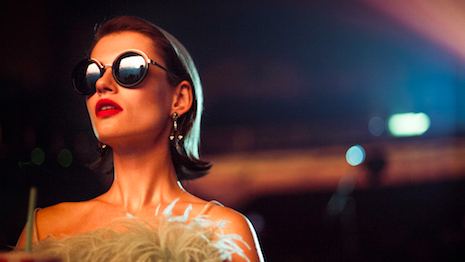
 Luxury brands make appearances on stage and screen. Image credit: Prada
Luxury brands make appearances on stage and screen. Image credit: Prada